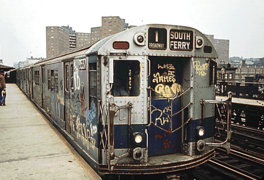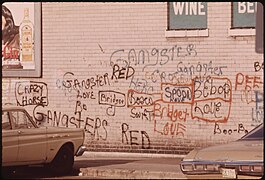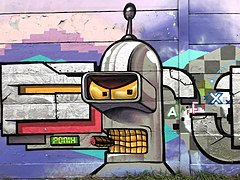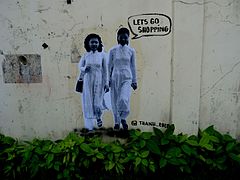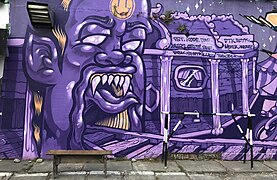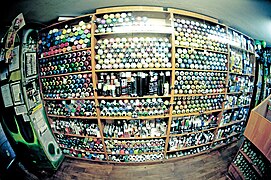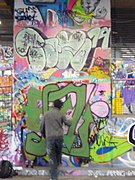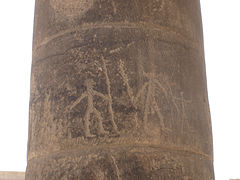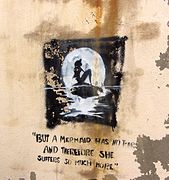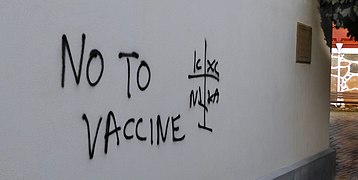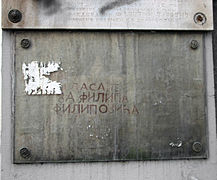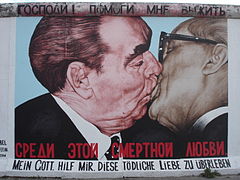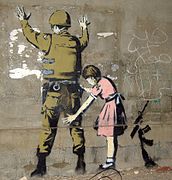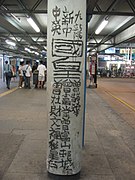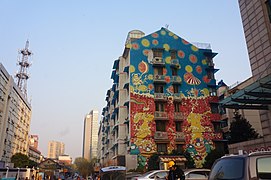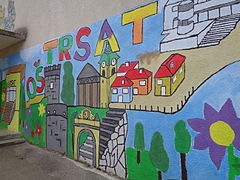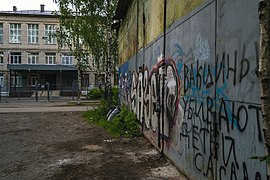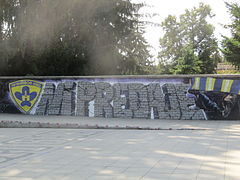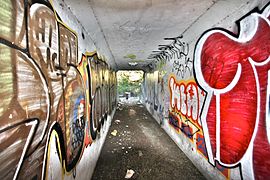Graffiti: Difference between revisions
Crazytonyi (talk | contribs) Tags: Mobile edit Mobile web edit |
|||
| Line 1: | Line 1: | ||
{{Short description|Drawings and paintings on walls}} |
|||
{{cleanup}} |
|||
{{Other uses}} |
|||
{{pp|small=yes}} |
|||
{{Original research|date=March 2019}} |
|||
[[File:Former roof felt factory in Tampere Jun2012 003.jpg|thumb|350px|An abandoned roof felt factory with graffiti in [[Santalahti]], [[Tampere]], [[Finland]]]] |
|||
: ''See also [[Graffiti (PalmOS)]] for the [[PalmOS]] handwriting system.'' |
|||
'''Graffiti''' (plural; singular '''''graffiti''''' or '''''graffito''''', the latter rarely used except in archeology) is art that is written, painted or drawn on a wall or other surface, usually without permission and within public view.<ref name=oxd/><ref name=ahd/> Graffiti ranges from simple written [[Moniker (graffiti)|"monikers"]] to elaborate wall paintings, and has existed [[Graffito (archaeology)|since ancient times]], with examples dating back to [[ancient Egypt]], [[ancient Greece]], and the [[Roman Empire]] (see also [[mural]]).<ref name="Graffito"/> |
|||
Graffiti is a controversial subject. In most countries, marking or painting property without permission is considered by property owners and civic authorities as defacement and [[vandalism]], which is a punishable crime, citing the use of graffiti by street gangs to mark territory or to serve as an indicator of gang-related activities.<ref>{{Cite web|url=http://www.lapdonline.org/get_informed/content_basic_view/23471|title=Why Gang Graffiti Is Dangerous—Los Angeles Police Department|website=www.lapdonline.org|language=en|access-date=19 February 2018|archive-date=20 February 2018|archive-url=https://web.archive.org/web/20180220033252/http://www.lapdonline.org/get_informed/content_basic_view/23471|url-status=dead}}</ref> Graffiti has become visualized as a growing urban "problem" for many cities in industrialized nations, spreading from the [[New York City Subway nomenclature|New York City subway]] system and [[Philadelphia]] in the early 1970s to the rest of the United States and Europe and other world regions.<ref>{{Cite book|title=Encyclopedia of the City|last=Caves|first=R. W.|publisher=Routledge|year=2004|pages=315}}</ref> |
|||
The term '''graffiti''' is the [[English plural|plural]] of ''graffito'', although the singular form is less commonly used. Both words have been borrowed from the [[Italian language]], and along with the English word "graphic", are in turn derived from the [[Greek language|Greek]] γραφειν (''graphein''), meaning ''to write''. In its modern day use, refers to deliberate human markings on property. Graffiti can take the form of art, drawings, or words, and is often illegal, especially when done without the property owner's consent. |
|||
== Etymology == |
|||
[[image:Gnv_lg_graffiti_wall.jpg|thumb|500px|right|This wall, in [[Gainesville, Florida]], has been set aside for use by graffiti artists and passersby.]] |
|||
[[File:Graffiti Kom Ombo.JPG|thumb|right|Ancient graffito in the [[Kom Ombo Temple]], Egypt]] |
|||
"Graffiti" (usually both singular and plural) and the rare singular form "graffito" are from the Italian word ''graffiato'' ("scratched").<ref>The Italian singular form "graffito" is so rare in English (except in specialist texts on archeology) that it is not even recorded or mentioned in some dictionaries, for example the Longman Dictionary of Contemporary English and the Cambridge Advanced Learner's Dictionary.</ref><ref name=oxd/><ref name="ahd">{{Cite web |last=Publishers |first=HarperCollins |title=The American Heritage Dictionary entry: graffiti |url=https://www.ahdictionary.com/word/search.html?q=graffiti |access-date=2024-03-26 |website=www.ahdictionary.com}}</ref> The term "graffiti" is used in [[art history]] for works of art produced by scratching a design into a surface. A related term is "[[sgraffito]]",<ref name=grant/> which involves scratching through one layer of pigment to reveal another beneath it. This technique was primarily used by potters who would glaze their wares and then scratch a design into them. In ancient times graffiti were carved on walls with a sharp object, although sometimes [[chalk]] or [[coal]] were used. The word originates from Greek {{lang|el|γράφειν}}—''graphein''—meaning "to write".<ref>{{Cite web|url=https://www.etymonline.com/word/graffiti|title=graffiti {{!}} Origin and meaning of graffiti by Online Etymology Dictionary|website=www.etymonline.com|language=en|access-date=19 February 2018}}</ref> |
|||
== |
== History == |
||
{{See also|Graffiti terminology|Roman graffiti|Megalithic graffiti symbols}} |
|||
[[File:Rufus est caricature villa misteri Pompeii.jpg|thumb|right|Ancient [[Pompeii]] graffito [[caricature]] of a politician. [[Villa of the Mysteries]].]] |
|||
[[File:Graffitti, Castellania, Malta.jpeg|thumb|right|Figure graffito, similar to a relief, at [[Castellania (Valletta)|the Castellania, in Valletta]]]] |
|||
'' |
The term ''graffiti'' originally referred to the [[inscription]]s, figure drawings, and such, found on the walls of ancient [[sepulchre]]s or ruins, as in the [[Catacombs of Rome]] or at [[Pompeii]]. Historically, these writings were not considered vandalism,<ref name=":2" /> which today is considered part of the definition of graffiti.<ref>{{cite web|title=How Old Is Graffiti?|url=http://wonderopolis.org/wonder/how-old-is-graffiti/|website=Wonderopolis|access-date=24 January 2017}}</ref> |
||
The only known source of the [[Safaitic]] language, an [[Old Arabic|ancient form of Arabic]], is from graffiti: inscriptions scratched on to the surface of rocks and boulders in the predominantly basalt desert of southern [[Syria]], eastern [[Jordan]] and northern [[Saudi Arabia]]. Safaitic dates from the first century BC to the fourth century AD.<ref>{{Cite web|url=http://krc2.orient.ox.ac.uk/aalc/index.php/en/safaitic-database-online|title=Ancient Arabia: Languages and Cultures—Safaitic Database Online|last=dan|website=krc2.orient.ox.ac.uk|language=en-gb|access-date=19 February 2018|archive-date=20 February 2018|archive-url=https://web.archive.org/web/20180220033117/http://krc2.orient.ox.ac.uk/aalc/index.php/en/safaitic-database-online|url-status=dead}}</ref><ref>{{Cite web|url=http://krc.orient.ox.ac.uk/ociana/index.php/safaitic|title=The Online Corpus of the Inscriptions of Ancient North Arabia—Safaitic|last=dan|website=krc.orient.ox.ac.uk|language=en-gb|access-date=19 February 2018|archive-date=20 February 2018|archive-url=https://web.archive.org/web/20180220033208/http://krc.orient.ox.ac.uk/ociana/index.php/safaitic|url-status=dead}}</ref> |
|||
The (believed to be) first example of "modern day" graffiti is found in the ancient Greek city of [[Ephesus]] in modern day [[Turkey]] and appears to be an advertisement for prostitution, according to the tour guides of the city. It is found near the long mosaic and stone walk way. It consists of a handprint, a vaguely heart-like shape, a footprint shape and a number. It is believed that this indicates how many steps one would have to take to find a lover with the handprint indicating payment. <!-- I will add a photo when I can find my photo taken in 1996 [[User:Alkivar]] --> |
|||
=== Ancient graffiti === |
|||
The [[ancient Rome|Romans]] carved graffiti into both their own walls and monuments and there are also, for instance, [[Egypt|Egyptian]] ones. The graffiti carved on the walls of [[Pompeii]] were preserved by the eruption of [[Vesuvius]] and offer us a direct insight into street life: everyday Latin, insults, magic, love declarations, political consigns. One example has even been found that stated "Cave Canem", which translates as "Beware of Dog". |
|||
Some of the oldest [[cave paintings]] in the world are 40,000 year old ones found in Australia.<ref name=":2">{{Cite book |last=McDonald |first=Fiona |url=https://books.google.com/books?id=ZnGCDwAAQBAJ |title=The Popular History of Graffiti: From the Ancient World to the Present |date=2013-06-13 |publisher=Simon and Schuster |isbn=978-1-62636-291-8 |language=en}}</ref> The oldest written graffiti was found in ancient Rome around 2500 years ago.<ref>{{Cite web |last1=Magazine |first1=Smithsonian |last2=Griggs |first2=Mary Beth |title=Archaeologists in Greece Find Some of the World's Oldest Erotic Graffiti |url=https://www.smithsonianmag.com/smart-news/erotic-graffiti-found-greece-180951979/ |access-date=2023-09-03 |website=Smithsonian Magazine |language=en}}</ref> Most graffiti from the time was boasts about sexual experiences.<ref>{{Cite news |last=Smith |first=Helena |date=2014-07-06 |title=2,500-year-old erotic graffiti found in unlikely setting on Aegean island |language=en-GB |work=The Guardian |url=https://www.theguardian.com/science/2014/jul/06/worlds-earliest-erotic-graffiti-astypalaia-classical-greece |access-date=2023-09-03 |issn=0261-3077}}</ref> Graffiti in Ancient Rome was a form of communication, and was not considered vandalism.<ref name=":2" /> |
|||
On the other hand, [[Viking]] graffiti can be found in [[Rome]], and [[Varangian]]s carved their [[rune]]s in [[Hagia Sophia]]. Many times in [[history]] graffiti were used as form of fight with opponents (see [[Orange Alternative]], for example). The Irish had their own inscriptive language called [[Ogham]]. |
|||
Ancient tourists visiting the 5th-century citadel at [[Sigiriya]] in Sri Lanka write their names and commentary over the "mirror wall", adding up to over 1800 individual graffiti produced there between the 6th and 18th centuries.<ref>{{Cite book |last1=Kljun |first1=Matjaž |last2=Pucihar |first2=Klen Čopič |title=Human-Computer Interaction – INTERACT 2015 |chapter="I Was Here": Enabling Tourists to Leave Digital Graffiti or Marks on Historic Landmarks |date=2015 |editor-last=Abascal |editor-first=Julio |editor2-last=Barbosa |editor2-first=Simone |editor3-last=Fetter |editor3-first=Mirko |editor4-last=Gross |editor4-first=Tom |editor5-last=Palanque |editor5-first=Philippe |editor6-last=Winckler |editor6-first=Marco |chapter-url=https://link.springer.com/chapter/10.1007/978-3-319-22723-8_45 |series=Lecture Notes in Computer Science |volume=9299 |language=en |location=Cham |publisher=Springer International Publishing |pages=490–494 |doi=10.1007/978-3-319-22723-8_45 |isbn=978-3-319-22723-8}}</ref> Most of the graffiti refer to the frescoes of semi-nude females found there. One reads: |
|||
[[Fresco|Frescos]] and [[Mural|murals]] are art forms that involve leaving images and writing on wall surfaces. Like the ancient cave wall paintings in [[France]], they are not graffiti, as they are created with the explicit permission (and usually support) of the owner of the walls. |
|||
{{poemquote|Wet with cool dew drops |
|||
==20th century== |
|||
fragrant with perfume from the flowers |
|||
[[Image:GraffitiArtist.jpg|thumb|left|A graffiti artist at work with spray paint.]] |
|||
came the gentle breeze |
|||
jasmine and water lily |
|||
dance in the spring sunshine |
|||
side-long glances |
|||
of the golden-hued ladies |
|||
stab into my thoughts |
|||
heaven itself cannot take my mind |
|||
as it has been captivated by one lass |
|||
among the five hundred I have seen here.<ref name=parana>{{cite book|last=Paranavithana|first=Senarath|title=Sigiri Graffiti; Being Sinhalese Verses of the Eighth, Ninth and Tenth Centuries|year=1956|publisher=Govt. of Ceylon by Oxford UP|location=London}}</ref>}} |
|||
Among the ancient political graffiti examples were [[Arab]] satirist poems. Yazid al-Himyari, an [[Umayyad]] Arab and [[Persian language|Persian]] poet, was most known for writing his political poetry on the walls between [[Sistan|Sajistan]] and [[Basra]], manifesting a strong hatred towards the [[Umayyad]] regime and its ''[[wali]]s'', and people used to read and circulate them very widely.<ref>حسين مروّة، '''تراثنا كيف نعرفه'''، مؤسسة الأبحاث العربية، بيروت، 1986{{clarify|date=October 2014}}</ref>{{clarify|date=October 2014}} |
|||
Starting with the large-scale urbanization of many areas in the 20th century, urban [[gang]]s would mark walls and other pieces of public property with the name of their gang (a "tag") in order to mark the gang's territory. |
|||
Graffiti, known as Tacherons, were frequently scratched on Romanesque Scandinavian church walls.<ref name="green" /> |
|||
Near the end of the twentieth century, the practice of tagging became increasingly non-gang related and began to be practiced for its own sake. Graffiti artists would sign their "tags" for the sake of doing so and sometimes to increase their reputation and prestige as a "writer" or a graffiti artist. |
|||
When [[Renaissance]] artists such as [[Pinturicchio]], [[Raphael]], [[Michelangelo]], [[Domenico Ghirlandaio|Ghirlandaio]], or [[Filippino Lippi]] descended into the ruins of Nero's [[Domus Aurea]], they carved or painted their names and returned to initiate the ''[[Grotesque|grottesche]]'' style of decoration.<ref name="archeology" /><ref name="atlantic" /> |
|||
There are also examples of graffiti occurring in American history, such as [[Independence Rock]], a national landmark along the [[Oregon Trail]].<ref>{{cite web|title=Independence Rock—California National Historic Trail (National Park Service)|url=https://www.nps.gov/cali/planyourvisit/site5.htm|publisher=National Park Service|access-date=18 January 2018}}</ref> |
|||
Tags, like [[screenname]]s, are sometimes chosen to reflect some qualities of the writer. Some tags also contain subtle and often cryptic messages. The year in which the tag or graffito was created, and in some cases the writer's initials or other letters, are sometimes incorporated into the tag. In some cases, tags or graffiti are dedicated or created in memory of a deceased friend, and might read something to the effect of "DIVA Peekrevs R.I.P. JTL '99". |
|||
<gallery mode="packed" caption="Ancient graffiti"> |
|||
In some cases, graffiti (especially those done in memory of a deceased person) found on storefront gates have been so elaborate that shopkeepers have been hesitant to clean them off. Other highly elaborate works covering otherwise unadorned fences or walls may likewise be so elaborate that property owners or the government may choose to keep them rather than cleaning them off. |
|||
File : Graffiti 4.JPG|<small>Graffiti from the Museum of Ancient Graffiti [[:fr:Maison du graffiti ancien|(fr)]], France </small> |
|||
2487(Admiror paries).jpg|Ironic wall inscription commenting on boring graffiti |
|||
Jesus graffito.jpg|Satirical [[Alexamenos graffito]], possibly the earliest known [[Depiction of Jesus|representation of Jesus]] |
|||
AncientgrafS.jpg|Graffiti, [[Church of the Holy Sepulchre]], [[Jerusalem]] |
|||
Crusader Graffiti in the Church of the holy supulchure Jerusalem Victor 2011 -1-21.jpg|Crusader graffiti in the Church of the Holy Sepulchre |
|||
Hagia-sofia-viking.jpg|[[Vikings|Viking]] mercenary graffiti at the [[Hagia Sophia]] in [[Istanbul]], Turkey |
|||
Sigiriya-graffiti.jpg|Graffiti on the [[Sigiriya#Mirror wall|Mirror Wall]], [[Sigiriya]], [[Sri Lanka]] |
|||
</gallery> |
|||
=== Contemporary graffiti === |
|||
In the 20th century, '[[Kilroy was Here]]' became a famous graffito, along with ''Mr. Chad'', a face with only the eyes and a nose hanging over the wall, saying "What No...?" (thing that lacked at the time) during the time of rationing. |
|||
Later, French soldiers carved their names on monuments during the Napoleonic [[French Revolutionary Wars: Campaigns of 1798|campaign of Egypt]] in the 1790s.<ref name="JinxArtCrimes" /> [[Lord Byron]]'s survives on one of the columns of the Temple of [[Poseidon]] at [[Cape Sounion]] in [[Attica]], Greece.<ref name="shanks" /> |
|||
Some graffiti may be local or regional in nature, such as wall tagging in [[Southern California]] by [[gang]]s such as the [[Bloods]] and the [[Crips]]. The name ''Cool "Disco" Dan'' (including the quotation marks) tends to be commonly seen in the [[Washington, DC]] area. Another famous graffiti in the [[Washington Metro|DC Metro]] area was found on the outer loop of the beltway on a railroad bridge near the [[Temple (Mormonism)|Mormon temple]] ([http://www.lds.org/temples/main/0,11204,1912-1-52-2,00.html seen here]), its simple scrawl "surrender dorothy" summoned visions of the Emerald City of [[Wizard of Oz|Oz]] and remained on the bridge for nearly 30 years (arrived sometime in 1973) before pressure from the Temple had it finally removed in 1999. |
|||
The oldest known example of graffiti monikers found on traincars created by hobos and railworkers since the late 1800s. The Bozo Texino monikers were documented by filmmaker [[Bill Daniel (filmmaker)|Bill Daniel]] in his 2005 film, ''Who is Bozo Texino?''.<ref name="bozo-texino-walker">{{cite web |last=Daniel |first=Bill |date=22 July 2010 |title=Who Is Bozo Texino? |url=https://walkerart.org/calendar/2010/who-is-bozo-texino |access-date=23 August 2018}}</ref><ref name="bozo-texino-film">{{cite web |last=Daniel |first=Bill |date=2005 |title=Who Is Bozo Texino? |url=http://www.billdaniel.net/who-is-bozo-texino/ |access-date=23 August 2018 |work=Who Is Bozo Texino? The Secret History of Hobo Graffiti}}</ref> |
|||
[[Image:Graffiti.jpg|thumb|300px|This construction scaffolding has been "tagged".]] |
|||
In [[World War II]], an inscription on a wall at the fortress of [[Verdun]] was seen as an illustration of the US response twice in a generation to the wrongs of the Old World:<ref name="reagan" /><ref>{{cite news|url=https://www.nytimes.com/1985/08/14/opinion/words-from-a-war.html|title=Words From a War|date=14 August 1985|newspaper=The New York Times|access-date=2 January 2017}}</ref> |
|||
A number of words and phrases have been coined to describe different styles and aspects of graffiti. A ''tag'' is a stylized signature, while a tagger or a ''writer'' is a person who "tags". A ''crew'' is a group of writers or graffiti artists. |
|||
{{poemquote| |
|||
Informal competition sometimes exists between taggers as to who can put up the most, or the most visible or artistic tags. Writers with the most tags up will gain respect among other graffiti artists, although they will also incur a greater risk that if caught by authorities, they will be held responsible for a greater number of tags. |
|||
Austin White – Chicago, Ill – 1918 |
|||
Austin White – Chicago, Ill – 1945 |
|||
This is the last time I want to write my name here.}} |
|||
During World War II and for decades after, the phrase "[[Kilroy was here]]" with an accompanying illustration was widespread throughout the world, due to its use by American troops and ultimately filtering into American popular culture. Shortly after the death of [[Charlie Parker]] (nicknamed "Yardbird" or "Bird"), graffiti began appearing around New York with the words "Bird Lives".<ref name=russel /> |
|||
To ''line'' somebody's tag is to put a line through it and is considered a deep insult. |
|||
<gallery mode="packed" caption="World War II graffiti"> |
|||
The phrase ''back to back'' refers to a graffito that is done all the way across a wall from one end to the next. This could be seen in some parts of the West side of the [[Berlin Wall]]. |
|||
Bundesarchiv Bild 101I-309-0816-20A, Italien, Soldat zeichnend.jpg|Soldier with tropical fantasy graffiti (1943–1944) |
|||
Graffiti inside the ruins of the German Reichstag building.jpg|Soviet Army graffiti in the ruins of the [[Reichstag building|Reichstag]], in [[Berlin]] (1945) |
|||
Kilroy Was Here - Washington DC WWII Memorial - Jason Coyne.jpg|Permanent engraving of [[Kilroy was here|Kilroy]] on the [[World War II Memorial]], in [[Washington, D.C.]] |
|||
</gallery><gallery mode="packed" caption="Early spray-painted graffiti"> |
|||
NYC R36 1 subway car.png|[[New York City Subway]] trains were covered in graffiti (1973). |
|||
GRAFFITI ON A WALL IN CHICAGO. SUCH WRITING HAS ADVANCED AND BECOME AN ART FORM, PARTICULARLY IN METROPOLITAN AREAS.... - NARA - 556232.jpg|Graffiti in [[Chicago]] (1973) |
|||
</gallery> |
|||
=== Modern Graffiti === |
|||
Theories and use of graffiti by [[avant-garde]] artists has a history dating at least to the [[Scandinavian Institute of Comparative Vandalism]] in [[1961]]. |
|||
Modern graffiti art has its origins with young people in 1960s and 70s in [[New York City]] and [[Philadelphia]]. [[Tag (graffiti)|Tags]] were the first form of stylised contemporary graffiti. Eventually, throw-ups and [[Piece (graffiti)|pieces]] evolved with the desire to create larger art. Writers used spray paint and other kind of materials to leave tags or to create images on the sides subway trains.<ref>{{Cite web |last=Tate |title=Graffiti art |url=https://www.tate.org.uk/art/art-terms/g/graffiti-art |access-date=2023-02-23 |website=Tate |language=en-GB}}</ref> and eventually moved into the city after the NYC metro began to buy new trains and paint over graffiti.<ref>{{Cite journal |last=Snyder |first=Gregory J. |date=2006-04-01 |title=Graffiti media and the perpetuation of an illegal subculture |url=http://journals.sagepub.com/doi/10.1177/1741659006061716 |journal=Crime, Media, Culture|language=en |volume=2 |issue=1 |pages=93–101 |doi=10.1177/1741659006061716 |s2cid=144911784 |issn=1741-6590}}</ref> |
|||
While the art had many advocates and appreciators—including the cultural critic [[Norman Mailer]]—others, including New York City mayor [[Ed Koch]], considered it to be defacement of public property, and saw it as a form of public blight.<ref name=":02">{{Cite web |title=The history of graffiti |url=https://learnenglishteens.britishcouncil.org/skills/reading/b2-reading/history-graffiti |access-date=2023-03-24 |website=learnenglishteens.britishcouncil.org |language=en}}</ref> The ‘taggers’ called what they did ‘writing’—though [[The Faith of Graffiti|an important 1974 essay]] by Mailer referred to it using the term ‘graffiti.’<ref name=":02"/> |
|||
Some of those who practice graffiti [[art]] are keen to distance themselves from [[gang]] graffiti. There are differences in both form and intent. The purpose of graffiti art is self-expression and creativity, and may involve highly stylized letter forms drawn with markers, or cryptic and colorful spray paint murals on walls, buildings, and even freight trains. Graffiti artists strive to improve their art, which is constantly changing and progressing. The purpose of gang graffiti, on the other hand, is to mark territorial boundaries, and is therefore limited to a gang's neighborhood; it does not presuppose artistic intent. |
|||
Contemporary graffiti style has been heavily influenced by [[hip hop culture]]<ref name="genius-paul-edwards-hiphopbook">{{cite web|url=https://genius.com/Paul-edwards-is-graffiti-really-an-element-of-hip-hop-book-excerpt-annotated|title=Is Graffiti Really An Element Of Hip-Hop? (book excerpt)|date=10 February 2015|work=The Concise Guide to Hip-Hop Music|access-date=23 August 2018|first=Paul|last=Edwards}}</ref> and the myriad international styles derived from [[Philadelphia]] and [[New York City Subway]] graffiti; however, there are many other traditions of notable graffiti in the twentieth century. Graffiti have long appeared on building walls, in [[latrine]]s, railroad [[boxcar]]s, [[rapid transit|subways]], and bridges. |
|||
An early graffito outside of New York or Philadelphia was the inscription in London reading "[[Clapton is God]]" in reference to the guitarist [[Eric Clapton]]. Creating the cult of the guitar hero, the phrase was spray-painted by an admirer on a wall in [[Islington]], north London, in the autumn of 1967.<ref>{{cite news |last1=Hann |first1=Michael |date=12 June 2011 |title=Eric Clapton creates the cult of the guitar hero |work=The Guardian |url=https://www.theguardian.com/music/2011/jun/12/eric-clapton |url-status=live |access-date=16 December 2016 |archive-url=https://web.archive.org/web/20170311172627/https://www.theguardian.com/music/2011/jun/12/eric-clapton |archive-date=11 March 2017}}</ref> The graffito was captured in a photograph, in which a dog is [[Urine marking#Canidae|urinating on the wall]].<ref>{{cite news |last=McCormick |first=Neil |date=24 July 2015 |title=Just how good is Eric Clapton? |work=The Telegraph |location=London |url=https://www.telegraph.co.uk/culture/music/rockandpopfeatures/11501274/Just-how-good-is-Eric-Clapton.html |url-status=live |access-date=3 April 2018 |archive-url=https://web.archive.org/web/20171124071909/http://www.telegraph.co.uk/culture/music/rockandpopfeatures/11501274/Just-how-good-is-Eric-Clapton.html |archive-date=24 November 2017}}</ref> |
|||
Films like [[Style Wars]] in the 80s depicting famous writers such as Skeme, [[DONDI|Dondi]], MinOne, and [[Zephyr (artist)|ZEPHYR]] reinforced graffiti's role within New York's emerging hip-hop culture. Although many officers of the New York City Police Department found this film to be controversial, Style Wars is still recognized as the most prolific film representation of what was going on within the young hip hop culture of the early 1980s.<ref name="labonte" /> Fab{{nbsp}}5 Freddy and Futura 2000 took hip hop graffiti to Paris and London as part of the New York City Rap Tour in 1983.<ref name="hershk" /> |
|||
==Legal situation== |
|||
=== Commercialization and entrance into mainstream pop culture === |
|||
[[Image:Graffitti-face.jpg|thumb|Illegal graffiti can be elaborate, but may be seen as a nuisance]] |
|||
{{Main|Commercial graffiti}} |
|||
With the popularity and legitimization of graffiti has come a level of commercialization. In 2001, computer giant [[IBM]] launched an advertising campaign in Chicago and San Francisco which involved people spray painting on sidewalks a [[peace symbol]], a [[Heart (symbol)|heart]], and a [[penguin]] ([[Tux (mascot)|Linux mascot]]), to represent "Peace, Love, and Linux." IBM paid Chicago and San Francisco collectively US$120,000 for punitive damages and clean-up costs.<ref name=guerilla/><ref name=wired/> |
|||
Graffiti is subject to different societal pressures from popularly-recognized art forms, since graffiti appears on walls, freeways, buildings, trains or any accessible surfaces that are not owned by the person who applies the graffiti. This means that graffiti forms incorporate elements rarely seen elsewhere. Spray paint and broad permanent markers are commonly used, and the organizational structure of the art is sometimes influenced by the need to apply the art quickly before it is noticed by authorities. |
|||
In 2005, a similar ad campaign was launched by [[Sony]] and executed by its advertising agency in New York, Chicago, Atlanta, Philadelphia, Los Angeles, and Miami, to market its handheld [[PlayStation Portable|PSP]] gaming system. In [[PlayStation Portable#Controversial advertising campaigns|this campaign]], taking notice of the legal problems of the IBM campaign, Sony paid building owners for the rights to paint on their buildings "a collection of dizzy-eyed urban kids playing with the PSP as if it were a skateboard, a paddle, or a rocking horse".<ref name=wired/><!-- Image with unknown copyright status removed: [[File:Yarnbus.jpg|thumb|This bus has been [[yarn bombing|yarn bombed]] by a team of knitters. {{Deletable image-caption|date=May 2012}}]] --> |
|||
In an effort to reduce vandalism, many cities have designated walls or areas exclusively for use by graffiti artists. It has been suggested that this discourages petty vandalism yet encourages artists to take their time and produce great art, without worry of being caught or arrested for vandalism or [[trespassing]]. Some disagree with this approach, arguing that the presence of legal graffiti walls has not been shown to reduce illegal graffiti elsewhere. |
|||
=== Global developments === |
|||
[[Image:Us-nogutsnofame.JPG|thumb|350px|left|Computer generated graffiti ''No Guts, No Fame'', its noticeable "anti-police" theme shows its artists frustration with the percieved illegal threat of graffiti.]] |
|||
==== South America ==== |
|||
Tristan Manco wrote that Brazil "boasts a unique and particularly rich, graffiti scene ... [earning] it an international reputation as the place to go for artistic inspiration". Graffiti "flourishes in every conceivable space in Brazil's cities". Artistic parallels "are often drawn between the energy of São Paulo today and 1970s New York". The "sprawling metropolis", of São Paulo has "become the new shrine to graffiti"; Manco alludes to "poverty and unemployment ... [and] the epic struggles and conditions of the country's marginalised peoples", and to "Brazil's chronic poverty", as the main engines that "have fuelled a vibrant graffiti culture". In world terms, Brazil has "one of the most uneven distributions of income. Laws and taxes change frequently". Such factors, Manco argues, contribute to a very fluid society, riven with those economic divisions and social tensions that underpin and feed the "folkloric vandalism and an urban sport for the disenfranchised", that is South American graffiti art.<ref name=manco7/> |
|||
Many people regard graffiti as an unwanted nuisance, or as expensive [[vandalism]] that must be repaired. It may be seen as a [[quality of life]] issue, and it is often suggested that the presence of graffiti contributes to a general sense of squalor and a heightened fear of [[crime]]. Advocates of the ''broken window theory'' believe that this sense of decay encourages further vandalism and leads to more serious offences being committed. |
|||
<!-- Deleted image removed: [[File:IMG 6754 3.jpg|thumb|Poetry graffiti in [[Tel Aviv]], [[Israel]]]] -->[[File:Graffiti in Tel Aviv, Israel.jpg|thumb|A graffiti piece by the artist DeDe found in [[Tel Aviv]]]] |
|||
To remove graffiti, [[high pressure cleaning]] can be used; it can also be painted over or, as a prevention, a specially formulated anti-graffiti coating can be applied to the surface of high-risk areas. |
|||
The [[Anti-Social Behaviour Act 2003]] is the latest anti-graffiti legislation to be passed in Britain. |
|||
Prominent Brazilian writers include [[OSGEMEOS|Os Gêmeos]], Boleta, [[Francisco Rodrigues da Silva|Nunca]], Nina, Speto, Tikka, and T.Freak.<ref name=globo/> Their artistic success and involvement in commercial design ventures<ref name=nicek/> has highlighted divisions within the Brazilian graffiti community between adherents of the cruder transgressive form of ''[[pichação]]'' and the more conventionally artistic values of the practitioners of ''grafite''.<ref name=revela/> |
|||
In [[August]] [[2004]], the [[Keep Britain Tidy]] campaign issued a [http://www.encams.org/News/newsRelease.asp?ArticleID=65&Sub=0&Menu=0.26.12.60 press release] calling for [[zero tolerance]] of graffiti, with support for proposals such as issuing "on the spot" [[fine]]s to graffiti offenders and banning the sale of aerosol paint to teenagers. The press release also condemned the use of graffiti images in advertising and in music videos, arguing that real world experience of graffiti was far from the 'cool' or 'edgy' image that was often portrayed. To back the campaign, 123 British [[Member of Parliament|MP]]s (including [[Prime Minister]] [[Tony Blair]]) signed a charter which stated: ''“Graffiti is not art, it’s crime. On behalf of my constituents, I will do all I can to rid our community of this problem.”'' |
|||
== |
==== Middle East ==== |
||
[[Image:Graffitiforvandalismarticle.jpg|thumb|300px|left|Graffiti in [[Melbourne]], Australia]] |
|||
The strand of graffiti art which is considered one of the four elements of [[hip hop]] is usually denoted urban ''''''Aerosol Art''''''. Sometimes synonymous with "hip-hop heads," so-called ''graffiti artists'' have gone beyond that stereotype and are abundant even among middle-class white children. There are different genres, from [[Philadelphia, Pennsylvania|Philly]]'s ''[[wicked style]]'' to [[California]] and [[New York]]'s ''[[wild style]]'' graffiti. Graffiti artists are classified based on their style or even on what surface they use. |
|||
Graffiti in the [[Middle East]] has emerged slowly, with taggers operating in [[Egypt]], [[Lebanon]], the [[Arab states of the Persian Gulf|Gulf countries]] like [[Bahrain]] or the [[United Arab Emirates]],<ref>{{Cite book|last1=Zoghbi|first1=Pascal|url=https://www.worldcat.org/oclc/818463305|title=Arabic graffiti = Ghirāfītī ʻArabīyah|last2=Stone|last3=Hawley|first3=Joy|date=2013|publisher=From Here to Fame|isbn=978-3-937946-45-0|location=Berlin|oclc=818463305}}</ref> [[Israel]], and in [[Iran]]. The major Iranian newspaper ''[[Hamshahri]]'' has published two articles on illegal writers in the city with photographic coverage of Iranian artist [[A1one]]'s works on Tehran walls. Tokyo-based design magazine, ''PingMag'', has interviewed A1one and featured photographs of his work.<ref name=pinmag/> The [[Israeli West Bank barrier]] has become a site for graffiti, reminiscent in this sense of the [[Berlin Wall]]. Many writers in Israel come from other places around the globe, such as JUIF from Los Angeles and DEVIONE from London. The religious reference "נ נח נחמ נחמן מאומן" ("[[Na Nach Nachma Nachman Meuman]]") is commonly seen in graffiti around Israel. |
|||
Graffiti [[tagging]] existed in [[Philadelphia]] during the [[1960s]], pioneered by ''Cornbread'' and ''Cool Earl''. Another Philadelphia product, ''Top Cat'', later exported the characteristic Philly style of script (tall, slender lettering with platforms at the bottom) to [[New York City]] where it gained popularity as "Broadway Elegant". It wasn't until it reached popularity in the [[New York City subway system]] that it took on an extravagant artistic role, expanding from tags to full-blown "pieces". |
|||
Graffiti has played an important role within the [[street art]] scene in the Middle East and North Africa ([[MENA]]), especially following the events of the [[Arab Spring]] of 2011 or the [[Sudanese Revolution]] of 2018/19.<ref>{{Cite web|title=Bashir's Overthrow Inspires Sudan Graffiti Artists|url=https://english.aawsat.com/home/article/1695246/bashirs-overthrow-inspires-sudan-graffiti-artists|access-date=2021-06-29|website=Asharq AL-awsat|language=en}}</ref> Graffiti is a tool of expression in the context of conflict in the region, allowing people to raise their voices politically and socially. Famous street artist [[Banksy]] has had an important effect in the street art scene in the MENA area, especially in [[State of Palestine|Palestine]] where some of his works are located in the [[Israeli West Bank barrier|West Bank barrier]] and [[Bethlehem]].<ref>{{Cite journal|last=DeTruk|first=Sabrina|date=2015|title=The "Banksy Effect" and Street Art in the Middle East|url=https://journals.ap2.pt/index.php/sauc/article/view/25|journal=SAUC – Street Art & Urban Creativity Scientific Journal|volume=1|issue=2|pages=22–30}}</ref> |
|||
One of the originators of New York graffiti was ''[[TAKI 183]]'' – a foot messenger who would tag his nickname around New York streets that he daily frequented en route. Taki was a [[Greek-American]] – his tag was diminutive for ''Demetrius'', while ''183'' came from his address. <!--A Greek-American, Taki was his nickname (diminutive for Demetrius); he took the ''183'' from his address. --> After being showcased in the [[New York Times]], his tag was being mimicked by hundreds of urban youth within months. |
|||
==== Southeast Asia ==== |
|||
It should be noted that there were other writers active in NYC before Taki, such as ''JULIO 204'', but he brought the most attention to the movement. With the innovation of art, and the craving to gain the widest audience, attempts by taggers were made. What developed was a strict adherence to spraypaint, sampling foreign [[calligraphy]], and the much anticipated [[mural]] (that usually covered an entire subway car). The artist was called a "[[writer]]," and so were groups of associated artists, called "crews". The movement spread on the streets, returned to the railroads where tagging was popularized by [[Hobo]]s, spread nationwide with the aid of media and [[Hip hop|rap music]]; thus, being yet mimicked again worldwide. |
|||
There are also a large number of graffiti influences in [[Southeast Asia]]n countries that mostly come from modern [[Western culture]], such as Malaysia, where graffiti have long been a common sight in Malaysia's capital city, [[Kuala Lumpur]]. Since 2010, the country has begun hosting a street festival to encourage all generations and people from all walks of life to enjoy and encourage Malaysian street culture.<ref name=kharbar/> |
|||
One of the earliest women to become active on the graffiti scene was New York City's "Lady Pink". Also known as Sandra Fabara, Lady Pink starred in the classic [[1982]] hip hop film "Wildstyle" when she was 18. |
|||
<gallery mode="packed" caption="Graffiti around the world"> |
|||
In the early 1980s, the combination of a booming art market and a renewed interest in painting resulted in the rise of a few graffiti artists to art-star status. [[Jean-Michel Basquiat]], a former street-artist known by his "Samo" tag, and [[Keith Haring]], a professionally-trained artist who adopted a graffiti style, were two of the most widely recognized graffiti artists. In some cases, the line between "simple" graffiti and unsanctioned works of [[public art]] can be difficult to draw. |
|||
File:Grafiti, Čakovec (Croatia).2.jpg|Graffiti on a wall in [[Čakovec]], Croatia |
|||
File:Graffiti in Budapest, Pestszentlőrinc.jpg|Graffiti of the character [[Bender (Futurama)|Bender]] on a wall in [[Budapest]], Hungary |
|||
File:Graffiti in Ho Chi Minh City.JPG|Graffiti in [[Ho Chi Minh City]], Vietnam |
|||
File:Mr. Wany's work-in-progress artwork for Kul Sign Festival.JPG|Graffiti art in [[Kuala Lumpur]], Malaysia |
|||
File:Graffiti in Yogyakarta, Indonesia.jpg|Graffiti in [[Yogyakarta]], Indonesia |
|||
File:Camperdown Memorial Rest Park Graffiti.jpg|Graffiti on a park wall in [[Sydney]], Australia |
|||
File:Graffitiensaopaulo.jpg|Graffiti in [[São Paulo]], Brazil |
|||
File:Absurdious-001.jpg|Absourdios. Tehran-Iran, 2009. |
|||
</gallery> |
|||
== Types of graffiti == |
|||
===Safety issues=== |
|||
{{See also|Graffiti terminology|Graffiti in the United States}} |
|||
Spray paint usually contains [[volatile organic compounds]] that are often highly toxic. Some graffiti artists who regularly work with spray paint develop [[neurology|neurological]] problems due to overexposure to VOCs. Compounds designed to remove graffiti can also be highly toxic (although the maintenance workers who work with these substances are usually more highly trained to use them safely.) [http://www.graffiti.org/faq/masks.html This article] from graffiti.org contains more information on the subject and recommends that spray painters wear a mask when painting. |
|||
=== Methods and production === |
|||
Some heavy duty [[permanent marker]]s also contain harmful VOCs, although the quantity of VOC released will probably be less than with spray paint. Those who use permanent markers should check the label and follow the safety instructions. |
|||
The modern-day graffitists can be found with an arsenal of various materials that allow for a successful production of a [[Piece (graffiti)|piece]].<ref name=nicolas/> This includes such techniques as [[Scribing (graffiti)|scribing]]. However, [[spray paint]] in aerosol cans is the number one medium for graffiti. From this commodity comes different styles, technique, and abilities to form master works of graffiti. Spray paint can be found at hardware and art stores and comes in virtually every color. |
|||
== Computer generated graffiti == |
|||
<gallery mode="packed" caption="Graffiti making"> |
|||
[[Image:Wiki-graffiti2.png|thumb|300px|left|Computer-generated graffiti reading "Wikipedia"]] |
|||
File:Vlg shop.jpg|The first graffiti shop in [[Russia]] was opened in 1992 in [[Tver]]. |
|||
File:Eurofestival graffiti 2.jpg|Graffiti application at Eurofestival in [[Turku]], Finland |
|||
File:Graffity in the making...(On a wall at Thrissur) CIMG9868.JPG|Graffiti application in India using natural pigments (mostly [[charcoal]], plant [[sap]]s, and dirt) |
|||
File:Graffity in the making...(On a wall at Thrissur) CIMG9873.jpg|Completed landscape scene, in [[Thrissur]], [[Kerala]], India |
|||
File:Leake Street TQ3079 352.JPG|A graffiti artist at work in [[London]] |
|||
</gallery> |
|||
=== Stencil graffiti === |
|||
Since many graffiti artists are considered vandals, many have moved to creating computer generated graffiti instead. Most of these types of artists are associated with [[ASCII art]], [[ANSI art]], and the [[Computer underground]]. |
|||
[[Stencil graffiti]] is created by cutting out shapes and designs in a stiff material (such as [[Corrugated fiberboard|cardboard]] or subject [[File folder|folder]]s) to form an overall design or image. The stencil is then placed on the "canvas" gently and with quick, easy strokes of the aerosol can, the image begins to appear on the intended surface. |
|||
==Graffiti Art Battle== |
|||
Some of the first examples were created in 1981 by artists [[Blek le Rat]] in Paris, in 1982 by [[Jef Aerosol]] in Tours (France);<ref>{{Cite web |last= |first= |date=2024-04-11 |title=The Evolution of Graffiti Art |url=https://artsfiesta.com/the-evolution-of-graffiti-art/ |access-date=2024-04-13 |website=Arts Fiesta |language=en-US}}</ref> by 1985 stencils had appeared in other cities including New York City, Sydney, and [[Melbourne]], where they were documented by American photographer Charles Gatewood and Australian photographer Rennie Ellis.<ref name="ellis" /> |
|||
In the early [[1980s]] one of the largest community "Graffiti Art Battles" took place next to the [[Bull Ring, Birmingham|Bull Ring]] shopping centre in [[Birmingham]], [[England]]. The city invited a selection of the UK's most renowned graffiti artists, including local artist ''[[Goldie]]'', [[Bristol]]'s ''[[Robert Del Naja|3D]]'' (who went on to form ''[[Massive Attack]]''), [[London]]'s ''[[Mode]]'' from the ''[[Chrome Angelz]]'', with [[Bronx]] Man ''[[Brim]]'' and his [[New York]] alter ego ''[[Bio (graffiti tagger)|Bio]]'' attending for good measure. |
|||
=== Tagging === |
|||
Massive boards were erected with scaffolding in place to enable free movement of the artists. It was a rare occasion of the age for so many prestigious artists to come together on one wall - many battles would lead to gang rivalry especially if one artist would "bite", or copy, another's style. Clips from the Battle can be seen in a [[Channel 4]] documentary titled ''Bombing''. |
|||
{{Main|Tag (graffiti)}} |
|||
Tagging is the practice of someone spray-painting "their name, initial or logo onto a public surface"<ref>{{Cite news|date=2022-01-18|title=Gullu Daley, Ajax Watson and Jestina Sharpe depicted in St Paul's street art|language=en-GB|work=BBC News|url=https://www.bbc.com/news/uk-england-bristol-60039912|access-date=2022-01-19}}</ref> in a [[handstyle]] unique to the writer. Tags were the first form of modern graffiti. |
|||
[[Image:banksy.bomb.jpg|thumb|225px|right|Stencil art by Banksy. Brick Lane, London]] |
|||
[[File:Tag by Spore.jpg|thumb|A tag in [[Dallas]], reading "Spore"]]A number of recent examples of graffiti make use of [[hashtags]].<ref>{{Cite web |date=2015-07-23 |title=Hashtag on the pavement connects with Fitzrovia's past |url=http://fitzrovianews.com/2015/07/23/hashtag-on-the-pavement-connects-with-fitzrovias-past/ |access-date=2024-03-26 |website=Fitzrovia News |language=en-GB}}</ref><ref>{{Cite web |date= |title=#RISKROCK #GRAFFITI IN #SANFRANCISCO |url=https://massappeal.com/riskrock-graffiti-in-san-francisco/ |archive-url=https://web.archive.org/web/20171011183228/https://massappeal.com/riskrock-graffiti-in-san-francisco/ |archive-date=2017-10-11 |website=Mass Appeal}}</ref> |
|||
{{wide image|Graffiti i baggård i århus 2c.jpg|1300px|align-cap=center|Densely-tagged parking area in [[Århus]], Denmark|center|}} |
|||
=== Modern experimentation === |
|||
==Street art== |
|||
[[File:Knitted graffiti 1.jpg|thumb|right|Knitted graffiti in [[Seattle]], Washington]] |
|||
In the '80s and early '90s the writers ''[[Cost (graffiti artist)|Cost]]'' and ''[[Revs]]'' were the first to get up with their name with the new techniques that would be a new form of graffiti, i.e. Post-Graffiti, or also known as Street Art. The participants use stencils, posters, stickers and installations to spread their art illegally in the streets. Since the '90s [[Shepard Fairey]] influenced many of today's street artists with his '[[Obey Giant]]' campaign. |
|||
[[File:Spiderweb Yarnbomb Installation by Stephen Duneier.JPG|thumbnail|Stephen Duneier's Spiderweb Yarnbomb installation hides and highlights previous graffiti.]] |
|||
Modern graffiti art often incorporates additional arts and technologies. For example, [[Graffiti Research Lab]] has encouraged the use of projected images and magnetic light-emitting diodes ([[LED art|throwies]]) as new media for graffitists. [[Yarn bombing|yarnbombing]] is another recent form of graffiti. Yarnbombers occasionally target previous graffiti for modification, which had been avoided among the majority of graffitists. |
|||
Other important Street Artists include C6.org, who incorporate new technologies into street graffiti art, [[Banksy]], probably the most famous of the stencil artists, D*Face (UK), [[Stak]], [[HNT]], [[Alexone]], [[André]] (France), [http://www.wearechangeagent.com/swoon/ Swoon], famous for the Cut-out Poster technique, Faile, (USA), [[Os Gemeos]], [[Herbert]] (Brazil), 6-_-©IIIII>@rtist.info, [[Flying Fortress (graffiti artist)|Flying Fortress]], [[Gomes]], [[Graffitilovesyou]], (Germany), Influenza, Erosie (Holland) and others. |
|||
== Uses == |
|||
A new form of tagging was created 1995 in Berlin by 6-_-©|||||>@rtist.info. He painted his 500 000 "6" tags with lime on wildly pasted posters, garbage and on the street . 30 % of his tags he painted while cycling. |
|||
Theories on the use of graffiti by [[avant-garde]] artists have a history dating back at least to the [[Asger Jorn]], who in 1962 painting declared in a graffiti-like gesture "the avant-garde won't give up".<ref>{{cite book | title=Expression as vandalism: Asger Jorn's "Modifications" | publisher=The University of Chicago Press | author=Karen Kurczynski | year=2008 | pages=293}}</ref> |
|||
== Radical and Political Graffiti == |
|||
Many contemporary analysts and even art critics have begun to see artistic value in some graffiti and to recognize it as a form of [[public art]]. According to many art researchers, particularly in the Netherlands and in Los Angeles, that type of public art is, in fact an effective tool of social [[emancipation]] or, in the achievement of a political goal.<ref name=thimar/> |
|||
Graffiti is sometimes seen as part of a subculture that rebels against extant societal authorities, or against authority as such. However these considerations are often divergent and relating to a wide range of practices. For some, graffiti is not only an art but also a lifestyle. For others it is a matter of political practice and forms just one tool in an array of methodologies and technologies or so-called anti-technologies of resistance. |
|||
In times of conflict, such murals have offered a means of communication and self-expression for members of these socially, ethnically, or racially divided communities, and have proven themselves as effective tools in establishing dialog and thus, of addressing cleavages in the long run. The [[Berlin Wall]] was also extensively covered by graffiti reflecting social pressures relating to the oppressive [[Soviet Union|Soviet]] rule over the [[East Germany|GDR]]. |
|||
The developments of graffiti art which took place in art galleries, colleges as well as "on the street" or "underground", contributed to the resurfacing in the 1990's of a far more overtly politicized form in the [[subvertising]], [[culture jamming]] or 'tactical media' movements. These movements or styles tend to classify the artists by their relationship to their social and economic contexts, since graffiti art is still illegal in many forms, in most countries. |
|||
Many artists involved with graffiti are also concerned with the similar activity of [[stenciling]]. Essentially, this entails stenciling a print of one or more colors using spray-paint. Recognized while [[Art exhibition|exhibiting]] and publishing several of her coloured stencils and paintings portraying the [[Sri Lankan Civil War]] and [[Urban area|urban Britain]] in the early 2000s, graffitists [[M.I.A. (artist)|Mathangi Arulpragasam, aka M.I.A.]], has also become known for integrating her imagery of political violence into her [[music videos]] for singles "[[Galang (song)|Galang]]" and "[[Bucky Done Gun]]", and her cover art. Stickers of her artwork also often appear around places such as London in [[Brick Lane]], stuck to lamp posts and street signs, she having become a muse for other graffitists and painters worldwide in cities including [[Seville]]. |
|||
Contemporary practitioners are therefore varied and often conflicting in their practices. There are those individuals such as [[Alexander Brener]] who have used the medium to politicise other art forms, and have taken the prison sentences forced onto them, as a means of further protest. Anonymous groups and individuals, however, are very varied also, with anonymous anti-capitalist art groups like the [[Space Hijackers]] who, in 2004, did an action about the capitalistic elments of [[Banksy]] and his use of political imagery. There are also those artists who are funded by a combination of government funding as well as commercial or private means, like irational.org who recently coined the term Advert Expressionism, replacing the word Abstract for Advert, in [[Clement Greenberg]]'s essay on [[Abstract Expressionism]]. |
|||
Graffitist believes that art should be on display for everyone in the public eye or in plain sight, not hidden away in a museum or a gallery.<ref name=":12">{{Cite web |title=Street and Graffiti Art Movement Overview |url=https://www.theartstory.org/movement/street-art/ |access-date=2023-03-24 |website=The Art Story |language=en}}</ref> Art should color the streets, not the inside of some building. Graffiti is a form of art that cannot be owned or bought. It does not last forever, it is temporary, yet one of a kind. It is a form of self promotion for the artist that can be displayed anywhere from sidewalks, roofs, subways, building wall, etc.<ref name=":12" /> Art to them is for everyone and should be showed to everyone for free. |
|||
See also: [[Writing]], [[visual art]], [[protest]] |
|||
=== Personal expression === |
|||
==Famous graffiti artists== |
|||
Graffiti is a way of communicating and a way of expressing what one feels in the moment. It is both art and a functional thing that can warn people of something or inform people of something. However, graffiti is to some people a form of art, but to some a form of vandalism.<ref name=":02"/> And many graffitists choose to protect their identities and remain anonymous or to hinder prosecution. |
|||
With the commercialization of graffiti (and [[Hip hop music|hip hop]] in general), in most cases, even with legally painted "graffiti" art, graffitists tend to choose anonymity. This may be attributed to various reasons or a combination of reasons. Graffiti still remains the [[hip hop#Culture|one of four hip hop elements]] that is not considered "performance art" despite the image of the "singing and dancing star" that sells hip hop culture to the mainstream. Being a graphic form of art, it might also be said that many graffitists still fall in the category of the [[Extraversion and introversion#Introversion|introverted archetypal artist]]. |
|||
===Hip-hop=== |
|||
* [[Robert Del Naja|3D]] from [[Massive Attack]] |
|||
* [[Brim]] |
|||
* [[DAIM]] |
|||
* [[Futura 2000]] |
|||
* [[Goldie]] |
|||
* [[Haze (graffiti artist)|Haze]] |
|||
* [[Jean-Michel Basquiat]] |
|||
* [[Loomit]] |
|||
* [[Mode2 (graffiti artist)|Mode2]] from [[Chrome Angels]] |
|||
* [[Neur]] |
|||
* [[Seen]] |
|||
* [[TAKI 183]] |
|||
[[Banksy]] is one of the world's most notorious and popular street artists who continues to remain faceless in today's society.<ref name=banksy/> He is known for his political, anti-war stencil art mainly in [[Bristol]], England, but his work may be seen anywhere from Los Angeles to [[Palestine (region)|Palestine]]. In the UK, Banksy is the most recognizable icon for this cultural artistic movement and keeps his identity a secret to avoid arrest. Much of Banksy's artwork may be seen around the streets of London and surrounding suburbs, although he has painted pictures throughout the world, including the Middle East, where he has painted on Israel's controversial [[West Bank]] barrier with satirical images of life on the other side. One depicted a hole in the wall with an idyllic beach, while another shows a mountain landscape on the other side. A number of [[Art exhibition|exhibitions]] also have taken place since 2000, and recent works of art have fetched vast sums of money. Banksy's art is a prime example of the classic controversy: vandalism vs. art. Art supporters endorse his work distributed in urban areas as pieces of art and some councils, such as Bristol and Islington, have officially protected them, while officials of other areas have deemed his work to be vandalism and have removed it. |
|||
===Street Art/Post Graffiti=== |
|||
* [[Banksy]] |
|||
* [[C6 (graffiti artist)|C6]] |
|||
[[Pixnit]] is another artist who chooses to keep her identity from the general public.<ref name=shaer/> Her work focuses on beauty and design aspects of graffiti as opposed to Banksy's anti-government shock value. Her paintings are often of flower designs above shops and stores in her local urban area of [[Cambridge, Massachusetts]]. Some store owners endorse her work and encourage others to do similar work as well. "One of the pieces was left up above Steve's Kitchen, because it looks pretty awesome"- Erin Scott, the manager of [[Tick (character)|New England Comics]] in [[Allston]], Massachusetts.<ref>{{Cite web|title=Pixnit was here {{!}} Stencil Archive|url=https://www.stencilarchive.org/content/pixnit-was-here|access-date=2021-06-03|website=www.stencilarchive.org}}</ref> |
|||
===Avant-Garde=== |
|||
* [[N.S.W Youth]] |
|||
Graffiti artists may become offended if photographs of their art are published in a commercial context without their permission. In March 2020, the [[Finland|Finnish]] graffiti artist Psyke expressed his displeasure at the newspaper ''[[Ilta-Sanomat]]'' publishing a photograph of a [[Peugeot 208]] in an article about new cars, with his graffiti prominently shown on the background. The artist claims he does not want his art being used in commercial context, not even if he were to receive compensation.<ref>Tamminen, Jari: ''Kuka omistaa graffitin?'' In ''[[Voima (newspaper)|Voima]]'' issue #1/2021, p. 40.</ref> |
|||
===Political=== |
|||
* [[Alexander Brener]] |
|||
* [[Asger Jorn]] |
|||
<gallery mode="packed" caption="Personal graffiti"> |
|||
===Misc=== |
|||
Graffiti at the Temple of Philae (XIII).jpg|Drawing at [[Philae temple complex|Temple of Philae]], [[Egypt]], depicting three men with rods, or staves |
|||
*[[Alexone]] |
|||
4091(Quisquis amat).jpg|Inscription in [[Pompeii]] lamenting a frustrated love: "Whoever loves, let him flourish, let him perish who knows not love, let him perish twice over whoever forbids love" |
|||
Post Apocalyptic Zombie Graffiti, Jan 2015.jpg|[[Apocalyptic and post-apocalyptic fiction|Post-apocalyptic]] despair |
|||
Mermaid Sliema.JPG|[[Mermaid]] in [[Sliema]], [[Malta]] |
|||
</gallery> |
|||
=== Territorial === |
|||
==External links== |
|||
Territorial graffiti marks urban neighborhoods with tags and logos to differentiate certain groups from others. These images are meant to show outsiders a stern look at whose turf is whose. The subject matter of gang-related graffiti consists of cryptic [[symbols]] and [[initials]] strictly fashioned with unique [[calligraphies]]. Gang members use graffiti to designate membership throughout the gang, to differentiate rivals and associates and, most commonly, to mark borders which are both territorial and ideological.<ref name="ley" /> |
|||
=== As advertising === |
|||
* [http://www.at149st.com/ @149<sup>st</sup>] New York graffiti |
|||
{{Unreferenced section|date=March 2009}} |
|||
* [http://bomblondon.com Bomblondon] Political graffiti |
|||
*[http://www.counterproductiveindustries.com/gbgc God Bless Graffiti Coalition] Pro graffiti organization |
|||
* [http://the-raw-prawn.blogspot.com/2004/09/mcdonalds-uses-graffiti-to-woo-us.html Graffiti as an advertising medium] |
|||
* [http://www.graffiticreator.net/ Graffiticreator.net] Create your own graffiti |
|||
* [http://www.graffiti.org Graffiti.org] Art Crimes: The Writing on the Wall |
|||
* [http://www.jdoodle.com/index.jsp JDoodle.com] A graffiti Wiki |
|||
* [http://www.encams.org Keep Britain Tidy] UK organisation, campaigns against graffiti |
|||
* [http://www.bastardartist.com Los Angeles Graffiti Art] |
|||
* [http://www.bok.net/~jig/mural/muralprep.html Making Your Mural Last: Graffiti, Varnish and Wall Chemistry] |
|||
*[http://www2.cr.nps.gov/tps/briefs/brief38.htm Removing Graffiti from Historic Masonry] by [[National Park Service]] |
|||
* [http://www.ukgraffiti.com/# UK Graffiti Artists Today] |
|||
* [http://www.violadoresdelverso.org/graffstock/graffstock.asp] [[Violadores del Verso]] Graffstock, [[Zaragoza, Spain]]. |
|||
Graffiti has been used as a means of advertising both legally and illegally. [[The Bronx|Bronx]]-based [[TATS CRU]] has made a name for themselves doing legal advertising campaigns for companies such as [[Coca-Cola]], [[McDonald's]], [[Toyota]], and [[MTV]]. In the UK, Covent Garden's [[Boxfresh]] used stencil images of a [[Zapatista Army of National Liberation|Zapatista]] revolutionary in the hopes that cross referencing would promote their store. |
|||
=== Street Art/ Post-Graffiti === |
|||
*[http://1kg.de 6-_-©||||||||>@rtist.info] Post-graffiti art from Germany |
|||
*[http://www.goabove.com Above] Street artist from California |
|||
*[http://www.banksy.co.uk Banksy] Stencil artists from England |
|||
*[http://www.daim.org Daim´s Homepage] Street artist from Germany |
|||
*[http://www.duncancumming.co.uk DuncanCumming.co.uk] |
|||
*[http://www.ekosystem.org Ekosystem] A Street-art portal |
|||
*[http://www.crcstudio.arts.ualberta.ca/scrawl Scrawl] Collection of street art from around the world |
|||
*[http://www.stencilrevolution.com Stencil Revolution] Biggest Stencil community on the web |
|||
*[http://www.thelondonpolice.com The London Police] Streetart from the Netherlands |
|||
*[http://www.woostercollective.com/ Wooster Collective: A Celebration of Street Art] |
|||
[[Smirnoff]] hired artists to use [[reverse graffiti]] (the use of high pressure hoses to clean dirty surfaces to leave a clean image in the surrounding dirt) to increase awareness of their product. |
|||
== In film == |
|||
<gallery mode="packed" caption="Advertising graffiti"> |
|||
*''Style Wars'': Directed by Tony Silver, Produced by Henry Chalfant. Represents a history of the [[1980s]] NYC graffiti scene as seen thru the eyes of its participants. [http://imdb.com/title/tt0177262/ Style Wars at imdb]. |
|||
1969(Lais felat).jpg|Ancient [[Pompeii]]an graffiti advertising by a [[Procuring (prostitution)|pimp]] |
|||
*''Turk 182'' ([[1985]]) is a fictional account of graffiti used for political purposes in New York City. The name might be a reference to TAKI 183. [http://www.imdb.com/title/tt0090217/ Turk 182 at imdb] |
|||
Grafitti as advertising in China 02.jpg|Graffiti as advertising in [[Haikou]], [[Hainan]] Province, China, which is an extremely common form of graffiti seen throughout the country |
|||
Warszawa Stary Mokotów graffiti on shop window.jpg|Graffiti as legal advertising on a grocer's shop window in [[Warsaw]], Poland |
|||
</gallery> |
|||
=== Radical and political === |
|||
== Literature == |
|||
*Reisser, Mwinkand, Behrend: ''[[DAIM]] - daring to push the boundaries'' getting-up/reisser (Germany) 2004 ISBN 3-00-014155-3 |
|||
*van Treeck, Bernhard: ''Das große Graffiti-Lexikon'', Lexikon-Imprint-Verlag, Berlin, 2001, ISBN 3-89601-292-X |
|||
*van Treeck, Bernhard and Metze-Prou, Sibylle: ''Pochoir - die Kunst des Schablonengraffiti'', Schwarzkopf & Schwarzkopf, Berlin, 2000, ISBN 3-89602-327-6 |
|||
*van Treeck, Bernhard: Street Art Berlin, Schwarzkopf und Schwarzkopf, Berlin, 1999 ISBN 3-89602-191-5 |
|||
*van Treeck, Bernhard: ''Wandzeichnungen, Edition aragon'', Moers, 1995 ISBN 3-89535-424-4 |
|||
*''Urban Discipline 2000 - Graffiti-Art'' Peters/Reisser/Zahlmann. 2000 Ausstellungskatalog getting-up (Germany) ISBN 3-00-006154-1 |
|||
*''Urban Discipline 2001 - Graffiti-Art'' Peters/Reisser/Zahlmann. 2001 Ausstellungskatalog getting-up (Germany) ISBN 3-00-007960-2 |
|||
*''Urban Discipline 2002 - Graffiti-Art'' Peters/Reisser/Zahlmann. 2002 Ausstellungskatalog getting-up (Germany) ISBN 3-00-009421-0 |
|||
*''Exhibizion, Z 2000'' Ute Baumgärtel. 2000 Ausstellungskatalog/Exhibition catalogue Akademie der Künste Berlin Die Gestalten Verlag (Deutschland) ISBN 3-931126-34-x |
|||
*''Graffiti Art #1 Deutschland - Germany'' Schwarzkopf & Schwarzkopf (Germany), ISBN 3-89602-028-5 |
|||
*''Graffiti Art #3 Writing in München'', 1995, Schwarzkopf & Schwarzkopf (Germany) ISBN 3-89602-045-5 |
|||
*''Graffiti Art #4 Ruhrgebiet-Rheinland'' Hrsg: O. Schwarzkopf. 1995 Schwarzkopf & Schwarzkopf (Germany) ISBN 3-89602-051-x |
|||
*''Graffiti Art #7 Norddeutschland'' 1997 Schwarzkopf & Schwarzkopf (Germany), ISBN 3-89602-136-2 |
|||
*''Graffiti Art #9 Wände'' Hrsg: B. van Treeck. 1998 Schwarzkopf & Schwarzkopf (Germany) ISBN 3-89602-161-3 |
|||
*''Graffiti Art #8 Charakters'' B. van Treeck. 1998 Schwarzkopf & Schwarzkopf (Germany) ISBN 3-89602-144-3 |
|||
*''Broken Windows Graffiti NYC'' James Murray, Karla Murray. 2002 Ginko Press (USA), ISBN 1-58423-078-9 |
|||
*''NYC Graffiti'', Michiko Rico Nosé. 2000 Graphic-Sha Publishing (Japan) ISBN 4-7661-1177-x |
|||
*''Graffiti Oggi'' Karin Dietz. 2001 Ausstellungskatalog/Exhibition catalogue, Arte Contemporanea Hirmer/M. Wiedemann (Italy) |
|||
*''Aspects of Graffiti'', Wortbüro Stefan Michel/Zürich. 2001 Ausstellungskatalog, Rote Fabrik (Switzerland) |
|||
*''Backjumps Sketch Book'', Adrian Nabi. 1996, Backjumps (Deutschland), ISBN 3-9806846-0-1 |
|||
*''HamburgCity Graffiti'', 2003, Publikat Verlag (Deutschland), ISBN 3-980-74786-7 |
|||
*''Cope 2, True Legend'', Donatien B. Orns. 2003, Righters.com (France), ISBN 2-9520-0608-6 |
|||
*''Le graffiti dans tous ses états'', 2002, Ausstellungskatalog, Taxie Gallery (France) |
|||
*AT Down, 2000, Octopus (Frankreich), ISBN 2-9516384-0-x |
|||
*Stylefile, Blackbook Sessions.01, Markus Christl. 2002, Publikat Verlag (Germany), ISBN 3-9807478-2-4 |
|||
*Hip-Hop Lexikon, S. Krekow, J. Steiner, M. Taupitz. 1999, Lexikon Imprint Verlag (Germany), ISBN 3-89602-205-9 |
|||
*Swiss Graffiti, S. von Koeding, B. Suter. 1998, Edition Aragon (Germany), ISBN 3-89535-461-9 |
|||
*Graffiti Lexikon, B. van Treeck. 1998, Schwarzkopf & Schwarzkopf (Germany), ISBN 3-89602-160-5 |
|||
*Writer Lexikon, Bernhard van Treeck, 1995, Edition Aragon (Germany), ISBN 3-89535-428-7 |
|||
*Street Art Köln, B. van Treeck. 1996, Edition Aragon (Germany), ISBN 3-89535-434-1 |
|||
*Hall of Fame, M. Todt, B. van Treeck . 1995, Edition Aragon (Germany), ISBN 3-89535-430-9 |
|||
*Best of German graffiti. Band 1, Timeless-X. 2001, Verlag H. M. Hauschild (Germany), ISBN 3-89757-121-8 |
|||
*Langages de Rue #2, Graff-It!. 2004, Verlag Graf-It! (France), ISBN 2-914714-02-5 |
|||
*Street Art, Tristan Manco. Thames & Hudson. 2004 (UK), ISBN 0-500-28469-5 |
|||
*Grafftit World, Nicholas Ganz. Thames & Hudson. 2004 (UK) ISBN 0-500-51170-5 |
|||
[[File:M2109 Iraq War Protest (Black Bloc Element).jpg|thumb|upright=1.05|[[Black bloc]] members spray graffiti on a wall during an [[Protests against the Iraq War#March 21, 2009|Iraq War Protest]] in Washington, D.C.]] |
|||
{{hiphop}} |
|||
Graffiti often has a reputation as part of a subculture that rebels against authority, although the considerations of the practitioners often diverge and can relate to a wide range of attitudes. It can express a political practice and can form just one tool in an array of resistance techniques. One early example includes the [[anarcho-punk]] band [[Crass]], who conducted a campaign of stenciling [[anti-war]], [[anarchism|anarchist]], [[feminism|feminist]], and [[Anti-consumerism|anti-consumerist]] messages throughout the [[London Underground]] system during the late 1970s and early 1980s.<ref name=souther/> In [[Amsterdam]] graffiti was a major part of the punk scene. The city was covered with names such as "De Zoot", "Vendex", and "Dr Rat".<ref name=stockho/> To document the graffiti a punk magazine was started that was called ''Gallery Anus''. So when hip hop came to Europe in the early 1980s there was already a vibrant graffiti culture. |
|||
[[Category:Art]] |
|||
[[Category:Crimes]] |
|||
[[File:Anarchy police.jpg|thumb|left|Police car graffitied with [[Anarchist symbolism|anarchist symbols]]]] |
|||
[[Category:Hip hop]] |
|||
The student protests and general strike of [[May 1968 in France|May 1968]] saw Paris bedecked in revolutionary, anarchistic, and situationist slogans such as ''L'ennui est contre-révolutionnaire'' ("Boredom is counterrevolutionary") and ''Lisez moins, vivez plus'' ("Read less, live more"). While not exhaustive, the graffiti gave a sense of the 'millenarian' and rebellious spirit, tempered with a good deal of verbal wit, of the strikers. |
|||
{{quote box|align=right|width=220px|quote=I think graffiti writing is a way of defining what our generation is like. Excuse the French, we're not a bunch of p---- artists. Traditionally artists have been considered soft and mellow people, a little bit kooky. Maybe we're a little bit more like pirates that way. We defend our territory, whatever space we steal to paint on, we defend it fiercely.|source=—Sandra "Lady Pink" Fabara<ref name=chang/>}} |
|||
The developments of graffiti art which took place in art galleries and colleges as well as "on the street" or "underground", contributed to the resurfacing in the 1990s of a far more overtly politicized art form in the [[subvertising]], [[culture jamming]], or tactical media movements. These movements or styles tend to classify the artists by their relationship to their social and economic contexts, since, in most countries, graffiti art remains illegal in many forms except when using non-permanent paint. Since the 1990s with the rise of [[Street Art]], a growing number of artists are switching to non-permanent paints and non-traditional forms of painting.<ref name="ziptopia-switch">{{cite web|url=https://www.zipcar.com/ziptopia/city-living/temporary-street-art-changing-the-graffiti-game|title=Temporary Street Art That's Changing The Graffiti Game|work=Ziptopia|first=STEVEN|last=HARRINGTON |access-date=26 August 2018}}</ref><ref name="huffpost-streetart">{{cite web|url=https://www.huffingtonpost.com/ron-english/street-art-its-not-meant-_b_5610496.html|title=Street Art: It's Not Meant to be Permanent|work=Huffington Post|first=Ron|last=English|date=6 December 2017|access-date=26 August 2018}}</ref> |
|||
Contemporary practitioners, accordingly, have varied and often conflicting practices. Some individuals, such as [[Alexander Brener]], have used the medium to politicize other art forms, and have used the prison sentences enforced on them as a means of further protest.<ref name="voice" /> |
|||
The practices of anonymous groups and individuals also vary widely, and practitioners by no means always agree with each other's practices. For example, the anti-capitalist art group the [[Space Hijackers]] did a piece in 2004 about the contradiction between the capitalistic elements of Banksy and his use of political [[imagery]].<ref name="tanyabaxter-Gallery">{{cite web|url=http://tanyabaxtercontemporary.com/banksy#!Banksy_Flying_Copper__screen_print_on_paper__100_x_70_cm|title= Banksy |work=Tanya Baxter Contemporary Gallery|access-date=26 August 2018}}</ref><ref name="haynes-banksy">{{cite web|url=http://www.haynesfineart.com/artists/Banksy--|title= Banksy |work=Haynes Fine Art|access-date=26 August 2018}}</ref> |
|||
Berlin human rights activist [[Irmela Mensah-Schramm]] has received global media attention and numerous awards for her 35-year campaign of effacing [[Neo-Nazism|neo-Nazi]] and other [[Far-right politics|right-wing extremist]] graffiti throughout Germany, often by altering hate speech in humorous ways.<ref name=":1">{{Cite news|last=Ramsel|first=Yannick|date=8 January 2021|title=Die Hakenkreuzjägerin|work=Der Spiegel|url=https://www.spiegel.de/politik/deutschland/irmela-mensah-schramm-beseitigt-rassistische-graffiti-und-aufkleber-die-hakenkreuzjaegerin-a-00000000-0002-0001-0000-000174784623}}</ref><ref name=":4">{{Cite news|last=Cataneo|first=Emily|date=12 April 2018|title=The Berliner Who Evaded Arrest|work=Off Assignment|url=https://www.offassignment.com/articles/emily-cataneo}}</ref> |
|||
[[File:Graffiti, George Floyd protest, Minneapolis, Minnesota, June 2020 (49997279552).jpg|thumb|"Fuck [[List of police-related slang terms#T|12]]", an [[Anti-police sentiment#United States|anti-police]] message insulting the police on a wall in [[Minneapolis]]]] |
|||
<gallery mode="packed" caption="Political graffiti around the world"> |
|||
File:Graffiti - No To Vaccine - Ystad-2021.jpg|Graffiti with orthodox cross at the Catholic Church in [[Ystad]], 2021 |
|||
File:Revolution - 2014.jpg|"Revolution". [[Sweden]], 2014. |
|||
File:Anti Iraqi war graffiti by street artist Sony Montana in Cancun, Mexico.jpg|Anti Iraqi war graffiti by street artist Sony Montana in [[Cancún]], Mexico (2007) |
|||
File:Vote for Filip Filipovic.jpg|Wall in [[Belgrade]], Serbia, with the slogan "Vote for [[Filip Filipović (politician)|Filip Filipović]]", who was the [[League of Communists of Yugoslavia|communist]] candidate for the [[mayor of Belgrade]] (1920) |
|||
File:The separation barrier which runs through Bethlehem.jpg|An interpretation of ''[[Liberty Leading the People]]'' on the separation barrier which runs through [[Bethlehem]] |
|||
File:BerlinAnhalterBunker.jpg|WWII bunker near [[Berlin Anhalter Bahnhof|Anhalter Bahnhof]] ([[Berlin]]) with a graffiti inscription ''Wer Bunker baut, wirft Bomben'' (those who build bunkers, throw bombs) |
|||
File:Amsterdam Grafitti Freedom Lives When the State Dies.png|Graffiti on the train line leading to Central Station in [[Amsterdam]] |
|||
File:Riia-002.JPG|"Let's JOKK" in [[Tartu]] refers to political scandal with the [[Estonian Reform Party]] (2012). |
|||
File:Pieksämäki - Kekkos-graffiti IMG 0227 C.JPG|Stencil in [[Pieksämäki]] representing former president of Finland, [[Urho Kekkonen]], well known in Finnish popular culture |
|||
File:Keep your rosaries graffiti.jpg|[[Female graffiti artists|Feminist graffiti]] in [[A Coruña]], Spain, that reads ''Enough with rosaries in our ovaries'' |
|||
File:Australia steals Timor Oil.jpg|[[East Timor]]ese protest against Australian petroleum extraction |
|||
File:Kiss-EastSideGallery.jpg|Graffiti of two [[Second World|communist]] leaders [[Socialist fraternal kiss|kissing]], on the [[Berlin Wall]] |
|||
File:Bethlehem Wall Graffiti 1.jpg|Ironic graffiti in [[Bethlehem]], Palestine |
|||
File:Berliner Mauer.jpg|[[Berlin Wall]]: "Anyone who wants to keep the world as it is, does not want it to remain" |
|||
File:ACAB - Cusco, Peru.jpg|A [[List of police-related slang terms#P|pig]] above [[ACAB]], beside [[anti-Fujimorism]] graffiti in [[Cusco]], Peru |
|||
</gallery> |
|||
=== Genocide denial === |
|||
{{Undue weight|date=December 2023}} |
|||
In [[Serbia]]n capital, [[Belgrade]], the graffiti depicting a uniformed former [[General officer|general]] of [[Army of Republika Srpska|Serb army]] and [[War Criminal|war criminal]], convicted at [[International Criminal Tribunal for the former Yugoslavia|ICTY]] for war crimes and crimes against humanity, including [[Bosnian genocide|genocide]] and [[Ethnic cleansing in the Bosnian War|ethnic cleansing]] in [[Bosnian War]], [[Ratko Mladić]], appeared in a military salute alongside the words "General, thank to your mother".<ref name="rferl.org">{{cite web |author1=Nevena Bogdanović |author2=Predrag Urošević |author3=Andy Heil |title=Graffiti War: Battle In The Streets Over Ratko Mladic Mural |url=https://www.rferl.org/a/serbia-mladic-mural-protests/31555357.html |website=Radio Free Europe / Radio Liberty |access-date=28 August 2022 |language=en |location=Belgrade |date=November 10, 2021}}</ref> |
|||
Aleks Eror, Berlin-based journalist, explains how "veneration of historical and wartime figures" through street art is not a new phenomenon in the region of former Yugoslavia, and that "in most cases is firmly focused on the future, rather than retelling the past".<ref name="calvertjournal.com-Eror">{{cite web |author1=Aleks Eror |title=How Serbian street art is using the past to shape the future |url=https://www.calvertjournal.com/articles/show/13353/ratko-mladic-mural-belgrade-serbia-are-revision-history-shape-future |website=The Calvert Journal |access-date=28 August 2022 |language=en |date=14 December 2021}}</ref> Eror is not only analyst pointing to danger of such an expressions for the region's future. In a long expose on the subject of [[Bosnian genocide denial]], at [[Balkan Diskurs]] magazine and multimedia platform website, Kristina Gadže and Taylor Whitsell referred to these experiences as a young generations' "cultural heritage", in which young are being exposed to celebration and affirmation of war-criminals as part of their "formal education" and "inheritance".<ref name="balkandiskurs.com">{{cite web |author1=Taylor Whitsell |author2=Kristina Gadže |title=New Generations Still Follow in a War Criminal's Footsteps |url=https://balkandiskurs.com/en/2021/12/15/new-generations-still-follow-in-a-war-criminals-footsteps/ |website=Balkan Diskurs |access-date=28 August 2022 |location=Belgrade |language=en |date=15 December 2021}}</ref> |
|||
[[File:Mural u Baru, prikaz ratnog zločinca Ratka Mladića.jpg|250px|thumb|right|Mural in [[Bar, Montenegro]], depicting the war criminal Ratko Mladić]] |
|||
There are numerous examples of genocide denial through celebration and affirmation of war criminals throughout the region of Western Balkans inhabited by Serbs using this form of artistic expression. Several more of these graffiti are found in Serbian capital, and many more across Serbia and Bosnian and Herzegovinian administrative entity, Republika Srpska, which is the ethnic Serbian majority enclave.<ref name="calvertjournal.com-Eror"/><ref name="ba.boell.org-Druško">{{cite web |author1=Dženana Karup-Druško |author1-link= |title=Denying genocide and celebrating war criminals may only be stopped by the adoption of a law that sanctions the actions |url=https://ba.boell.org/en/2019/05/16/denying-genocide-and-celebrating-war-criminals-may-only-be-stopped-adoption-law-sanctions |website=Heinrich-Böll-Stiftung |access-date=28 August 2022 |location=Sarajevo |language=en |date=16 May 2019}}</ref> Critics point that Serbia as a state, is willing to defend the mural of convicted war criminal, and have no intention to react on cases of genocide denial, noting that [[Ministry of Internal Affairs (Serbia)|Interior Minister of Serbia]], [[Aleksandar Vulin]] decision to ban any gathering with an intent to remove the mural, with the deployment of riot police, sends the message of "tacit endorsement".<ref name="rferl.org"/><ref name="europeanwesternbalkans.com-Popović"/> Consequently, on 9 November 2021, Serbian heavy police in riot gear, with graffiti creators and their supporters,<ref name="balkandiskurs.com"/> blocked the access to the mural to prevent human rights groups and other activists to paint over it and mark the [[International Day Against Fascism and Antisemitism]] in that way,<ref name="rferl.org"/> and even arrested two civic activist for throwing eggs at the graffiti.<ref name="europeanwesternbalkans.com-Popović">{{cite web |author1=Sofija Popović |title=The case of Mladić mural shows that authorities in Serbia have no intention to deal with war crimes |url=https://europeanwesternbalkans.com/2021/11/12/the-case-of-mladic-mural-shows-that-authorities-in-serbia-have-no-intention-to-deal-with-war-crimes/ |website=European Western Balkans |access-date=28 August 2022 |location=Belgrade |date=12 November 2021}}</ref> |
|||
=== Offensive graffiti === |
|||
[[File:One World !.jpg|thumb|"One World"]] |
|||
[[File:Stop graffitti.jpg|thumb|Gang symbol markings on public property, [[Millwood, Washington]]]] |
|||
Graffiti may also be used as an offensive expression. This form of graffiti may be difficult to identify, as it is mostly removed by the local authority (as councils which have adopted strategies of criminalization also strive to remove graffiti quickly).<ref name=halsey/> Therefore, existing racist graffiti is mostly more subtle and at first sight, not easily recognized as "racist". It can then be understood only if one knows the relevant "local code" (social, historical, political, temporal, and spatial), which is seen as [[heteroglossia|heteroglot]] and thus a 'unique set of conditions' in a cultural context.<ref name=holqu/> |
|||
:A spatial code for example, could be that there is a certain youth group in an area that is engaging heavily in racist activities. So, for residents (knowing the local code), a graffiti containing only the name or abbreviation of this gang already is a racist expression, reminding the offended people of their gang activities. Also a graffiti is in most cases, the [[herald]] of more serious criminal activity to come.<ref name=kelling/> A person who does not know these gang activities would not be able to recognize the meaning of this graffiti. Also if a tag of this youth group or gang is placed on a building occupied by asylum seekers, for example, its racist character is even stronger. |
|||
By making the graffiti less explicit (as adapted to social and legal constraints),<ref name=barker/> these drawings are less likely to be removed, but do not lose their threatening and offensive character.<ref name=lynn/> |
|||
Elsewhere, activists in Russia have used painted [[caricature]]s of local officials with their mouths as [[pothole]]s, to show their anger about the poor state of the roads.<ref>{{cite news |last=Schreck |first=Carl |date=19 June 2015 |title=Russian politicians mocked with guerrilla pothole portraits |url=https://www.theguardian.com/world/2015/jun/19/russia-pothole-portraits-activists-banksy |website= New East Network |access-date=24 September 2015}}</ref> In [[Manchester]], England, a graffitists painted obscene images around potholes, which often resulted in them being repaired within 48 hours.<ref>{{cite news |date=29 April 2015 |title=Meet the man using penises to fill potholes |url=https://www.telegraph.co.uk/men/the-filter/11570595/Meet-the-man-using-penises-to-fill-potholes.html |archive-url=https://ghostarchive.org/archive/20220111/https://www.telegraph.co.uk/men/the-filter/11570595/Meet-the-man-using-penises-to-fill-potholes.html |archive-date=2022-01-11 |url-access=subscription |url-status=live |website= The Telegraph |access-date=24 September 2015}}{{cbignore}}</ref> |
|||
== Decorative and high art == |
|||
{{Main|Street art}} |
|||
[[File:JonesyLondon.jpg|thumb|upright|A bronze work by Jonesy on a wall in Brick Lane ([[London]]). Diameter about 8 cm.]] |
|||
In the early 1980s, the first art galleries to show graffitists to the public were [[Fashion Moda]] in [[the Bronx]], [[Now Gallery]] and [[Fun Gallery]], both in the [[East Village, Manhattan]].<ref name="openedition-fashionmoda">{{cite journal|url=https://journals.openedition.org/rrca/601|title=From the Street to Art Galleries : How Graffiti Became a Legitimate Art Form|date=2014|access-date=26 August 2018|journal=Open Edition|first=David|last=diallo}}</ref><ref name="hyperallergic-fashionmoda">{{cite web|url=https://hyperallergic.com/227683/35-years-after-fashion-moda-a-bronx-gallery-revisits-the-landmark-space/|title=35 Years After Fashion Moda, a Bronx Gallery Revisits the Landmark Space|date=6 August 2015|access-date=26 August 2018|work=Hyperallergic|first= Tiernan |last= Morgan}}</ref><ref name="nytimes-fashionmoda">{{cite news|url=https://www.nytimes.com/2012/03/25/nyregion/recreating-the-fashion-moda-exhibition-of-1982.html |archive-url=https://ghostarchive.org/archive/20220102/https://www.nytimes.com/2012/03/25/nyregion/recreating-the-fashion-moda-exhibition-of-1982.html |archive-date=2022-01-02 |url-access=limited |url-status=live|title=When a South Bronx Collective Went International|date=23 March 2012|access-date=26 August 2018|newspaper=New York Times|first=SUSAN |last=HODARA}}{{cbignore}}</ref><ref name="nydaily-fashionmoda">{{cite web|url=http://www.nydailynews.com/new-york/bronx/fashion-moda-old-haven-artists-south-bronx-focus-special-event-saturday-article-1.1263587|title=The legacy of Fashion Moda, a shuttered art and performance space, to be spotlighted |date=15 February 2013 |access-date=26 August 2018 |work=New York Daily News|first=TANYANIKA |last=SAMUELS }}</ref> |
|||
A 2006 exhibition at the [[Brooklyn Museum]] displayed graffiti as an art form that began in [[Boroughs of New York City|New York's outer boroughs]] and reached great heights in the early 1980s with the work of Crash, Lee, Daze, [[Keith Haring]], and [[Jean-Michel Basquiat]]. It displayed 22 works by New York graffitists, including [[Crash (graffiti artist)|Crash]], Daze, and [[Lady Pink]]. In an article about the exhibition in the magazine ''Time Out'', curator Charlotta Kotik said that she hoped the exhibition would cause viewers to rethink their assumptions about graffiti. |
|||
From the 1970s onwards, [[Burhan Doğançay]] photographed urban walls all over the world; these he then archived for use as sources of inspiration for his painterly works. The project today known as "Walls of the World" grew beyond even his own expectations and comprises about 30,000 individual images. It spans a period of 40 years across five continents and 114 countries. In 1982, photographs from this project comprised a one-man exhibition titled "Les murs murmurent, ils crient, ils chantent{{nbsp}}..." (The walls whisper, shout and sing{{nbsp}}...) at the [[Centre Pompidou|Centre Georges Pompidou]] in [[Paris]]. |
|||
In Australia, art historians have judged some local graffiti of sufficient creative merit to rank them firmly within the arts. [[Oxford University Press]]'s art history text ''Australian Painting 1788–2000'' concludes with a long discussion of graffiti's key place within contemporary [[visual culture]], including the work of several Australian practitioners.<ref name=smithea/> |
|||
Between March and April 2009, 150 artists exhibited 300 pieces of graffiti at the [[Grand Palais]] in Paris.<ref name=rfi/><ref name=rohter/> |
|||
<gallery mode="packed" caption="Street art graffiti"> |
|||
File:Graffiti Obelisco.jpg|Graffiti in [[Buenos Aires]], showing the [[Obelisco de Buenos Aires|Obelisk]] |
|||
File:Graffiti (Budapest, Pestszentlőrinc).jpg|Graffiti on a wall in [[Budapest]], Hungary |
|||
File:Graffiti in Tikkurila.jpg|Graffiti on the wall of pedestrian tunnel in [[Tikkurila]], [[Vantaa]], Finland |
|||
</gallery> |
|||
== Environmental effects == |
|||
[[Spray paint]] has many negative environmental effects. The paint contains toxic chemicals, and the can uses volatile hydrocarbon gases to spray the paint onto a surface.<ref>{{Cite web|url=http://www.hercenter.org/facilitiesandgrounds/paints.php#healthenv|title=Health and Environmental Issues of Spray Paint|website=Healthcare Environmental Resource Center|access-date=30 April 2019}}</ref> |
|||
[[Volatile organic compound]] (VOC) leads to ground level ozone formation and most of graffiti related emissions are VOCs.<ref name="Leskys">{{Cite web|url=https://www3.epa.gov/ttn/chief/conference/ei19/session7/leskys.pdf |archive-url=https://web.archive.org/web/20110204080037/http://www.epa.gov/ttn/chief/conference/ei19/session7/leskys.pdf |archive-date=2011-02-04 |url-status=live|title=Establishing Graffiti Emissions as a Nonpoint Source Sector|last=Leskys|first=AM|date=September 2010}}</ref> A 2010 paper estimates 4,862 tons of VOCs were released in the United States in activities related to graffiti.<ref name="Leskys" /><ref name="EPA">{{Cite web|url=https://www3.epa.gov/ttn/chief/conference/ei19/index.html|title=19th International Emission Inventory Conference "Emission Inventories—Informing Emerging Issues" September 2010|website=EPA}}</ref> |
|||
== Government responses == |
|||
[[File:US military anti-graffiti poster in Kuwait.png|thumb|upright|Poster at a US military base in [[Kuwait]] decrying graffiti, itself having been graffitied]] |
|||
=== Asia === |
|||
In China, [[Mao Zedong]] in the 1920s used revolutionary slogans and paintings in public places to galvanize the country's communist movement.<ref name=bbc/> |
|||
Based on different national conditions, many people believe that China's attitude towards Graffiti is fierce, but in fact, according to Lance Crayon in his film ''Spray Paint Beijing: Graffiti in the Capital of China'', Graffiti is generally accepted in [[Beijing]], with artists not seeing much police interference. Political and religiously sensitive graffiti, however, is not allowed.<ref>{{Cite web|url=https://www.pri.org/stories/2014-04-21/beijings-thriving-graffiti-culture-may-surprise-you|title=Beijing's thriving graffiti culture may surprise you|website=Public Radio International|language=en|access-date=24 April 2019}}</ref> |
|||
In Hong Kong, [[Tsang Tsou Choi]] was known as the ''King of Kowloon'' for his [[calligraphy]] graffiti over many years, in which he claimed ownership of the area. Now some of his work is preserved officially. |
|||
In [[Taiwan]], the government has made some concessions to graffitists. Since 2005 they have been allowed to freely display their work along some sections of riverside retaining walls in designated "Graffiti Zones".<ref name=taitimes/> From 2007, Taipei's department of cultural affairs also began permitting graffiti on fences around major public construction sites. Department head Yong-ping Lee (李永萍) stated, "We will promote graffiti starting with the public sector, and then later in the private sector too. It's our goal to beautify the city with graffiti". The government later helped organize a graffiti contest in [[Ximending]], a popular shopping district. Graffitists caught working outside of these designated areas still face fines up to [[NT$]]6,000 under a department of environmental protection regulation.<ref name=taitimes2/> However, Taiwanese authorities can be relatively lenient, one veteran police officer stating anonymously, "Unless someone complains about vandalism, we won't get involved. We don't go after it proactively."<ref name=reuters/> |
|||
In 1993, after several expensive cars in [[Singapore]] were spray-painted, the police arrested a student from the [[Singapore American School]], [[Michael P. Fay]], questioned him, and subsequently charged him with vandalism. Fay pleaded guilty to vandalizing a car in addition to stealing road signs. Under the 1966 [[Vandalism Act (Singapore)|Vandalism Act of Singapore]], originally passed to curb the spread of communist graffiti in Singapore, the court sentenced him to four months in jail, a fine of S$3,500 (US$2,233), and a [[caning]]. ''[[The New York Times]]'' ran several editorials and op-eds that condemned the punishment and called on the American public to flood the Singaporean embassy with protests. Although the Singapore government received many calls for [[pardon|clemency]], Fay's caning took place in Singapore on 5 May 1994. Fay had originally received a sentence of six strokes of the cane, but the presiding [[president of Singapore]], [[Ong Teng Cheong]], agreed to reduce his caning sentence to four lashes.<ref name=nyt/> |
|||
In [[Republic of Korea|South Korea]], Park Jung-soo was fined two million [[South Korean won]] by the [[Seoul]] Central District Court for spray-painting a rat on posters of the [[G-20]] Summit a few days before the event in November 2011. Park alleged that the initial in "G-20" sounds like the Korean word for "rat", but Korean government prosecutors alleged that Park was making a derogatory statement about the president of South Korea, [[Lee Myung-bak]], the host of the summit. This case led to public outcry and debate on the lack of government tolerance and in support of freedom of expression. The court ruled that the painting, "an ominous creature like a rat" amounts to "an organized criminal activity" and upheld the fine while denying the prosecution's request for imprisonment for Park.<ref name=wsj/> |
|||
<gallery mode="packed" caption="Graffiti in Asia"> |
|||
File:Tsang graffiti.jpg|Street [[graffiti in Hong Kong]] |
|||
File:201712 Graffiti on a building of Shentangqiao1.jpg|The Graffiti Piece "Tante" (by Chen Dongfan) on the surface wall of an old residential building in [[Hangzhou]], [[Zhejiang]], China |
|||
</gallery> |
|||
=== Europe === |
|||
[[File:Graffiti removal berlin.jpg|thumb|upright|Graffiti removal in [[Berlin]]]] |
|||
In Europe, community cleaning squads have responded to graffiti, in some cases with reckless abandon, as when in 1992 in France a local Scout group, attempting to remove modern graffiti, damaged [https://web.archive.org/web/20171109194433/http://www.panoramio.com/photo/26895452 two prehistoric paintings] of [[bison]] in the [[Cave of Mayrière supérieure]] near the French village of [[Bruniquel]] in [[Tarn-et-Garonne]], earning them the 1992 [[Ig Nobel Prize]] in [[archeology]].<ref name=improb/> |
|||
In September 2006, the European Parliament directed the European Commission to create urban environment policies to prevent and eliminate dirt, litter, graffiti, animal excrement, and excessive noise from domestic and vehicular music systems in European cities, along with other concerns over urban life.<ref name=europa/> |
|||
In [[Budapest]], Hungary, both a city-backed movement called ''I Love Budapest'' and a special police division tackle the problem, including the provision of approved areas.<ref name=index/> |
|||
=== United Kingdom === |
|||
{{Main|Graffiti in the United Kingdom}} |
|||
The [[Anti-social Behaviour Act 2003]] became Britain's latest anti-graffiti legislation. In August 2004, the [[Keep Britain Tidy]] campaign issued a press release calling for [[zero tolerance]] of graffiti and supporting proposals such as issuing "on the spot" [[Fine (penalty)|fine]]s to graffiti offenders and banning the sale of aerosol paint to anyone under the age of 16.<ref name=encams/> The press release also condemned the use of graffiti images in advertising and in [[music video]]s, arguing that real-world experience of graffiti stood far removed from its often-portrayed "cool" or "edgy'" image. |
|||
To back the campaign, 123 [[Member of Parliament (United Kingdom)|Members of Parliament]] (MPs) (including then Prime Minister [[Tony Blair]]), signed a charter which stated: "Graffiti is not art, it's crime. On behalf of my constituents, I will do all I can to rid our community of this problem."<ref name=wire/> |
|||
In the UK, city councils have the power to take action against the owner of any property that has been defaced under the [[Anti-social Behaviour Act 2003]] (as amended by the [http://www.opsi.gov.uk/acts/acts2005/ukpga_20050016_en_1 Clean Neighbourhoods and Environment Act 2005]) or, in certain cases, the Highways Act. This is often used against owners of property that are complacent in allowing protective boards to be defaced so long as the property is not damaged.{{citation needed|date=July 2018}} |
|||
In July 2008, a [[Criminal conspiracy|conspiracy]] charge was used to convict graffitists for the first time. After a three-month police surveillance operation,<ref name=bbc2/> nine members of the DPM crew were convicted of conspiracy to commit [[Property damage|criminal damage]] costing at least £1 million. Five of them received prison sentences, ranging from eighteen months to two years. The unprecedented scale of the investigation and the severity of the sentences rekindled public debate over whether graffiti should be considered art or crime.<ref name=indep/> |
|||
Some councils, like those of Stroud and Loerrach, provide approved areas in the town where graffitists can showcase their talents, including underpasses, car parks, and walls that might otherwise prove a target for the "spray and run".<ref name=bbc3/> |
|||
<gallery mode="packed" caption="Graffiti in Europe"> |
|||
File:Mur de tags au Forum de Barcelone.jpg|Multi-artist graffiti in [[Barcelona]], Spain |
|||
File:KGD zumaia 1.jpg|Integration of graffiti into its environment, [[Zumaia]], Spain (2016) |
|||
File:Grafiti na Trsatu, Rijeka (Croatia).jpg|Graffiti made by school children in [[Rijeka]], Croatia |
|||
File:ქორქ?.jpg|Graffiti written in [[Georgian scripts|Georgian script]], [[Tbilisi]], Georgia |
|||
File:Princip Gavrilo grafit.JPG|Historical graffito of [[Gavrilo Princip]] in [[Belgrade]], Serbia |
|||
File:NN 07-08-2020 46.jpg|Graffiti on a garage near a school in [[Nizhny Novgorod]], Russia |
|||
File:Stadion Ljudski Vrt (19577579076).jpg|[[Association football|Football]] related graffiti in [[Maribor]], Slovenia |
|||
File:Our Lady of the Hattifatteners (cropped).jpg|Graffiti by [[Hazul]] in [[Porto]], Portugal |
|||
</gallery> |
|||
=== Australia === |
|||
[[File:Graffiti tunnel 2009, University of Sydney.jpg|thumb|Graffiti Tunnel, University of Sydney at [[Camperdown, New South Wales|Camperdown]] (2009)]] |
|||
In an effort to reduce vandalism, many cities in Australia have designated walls or areas exclusively for use by graffitists. One early example is the "Graffiti Tunnel" located at the [[Camperdown, New South Wales|Camperdown]] Campus of the [[University of Sydney]], which is available for use by any student at the university to tag, advertise, poster, and paint. Advocates of this idea suggest that this discourages petty vandalism yet encourages artists to take their time and produce great art, without worry of being caught or arrested for vandalism or [[trespassing]].<ref name=warrin/><ref name=abc/> Others disagree with this approach, arguing that the presence of legal graffiti walls does not demonstrably reduce illegal graffiti elsewhere.<ref name=towno/> Some local government areas throughout Australia have introduced "anti-graffiti squads", who clean graffiti in the area, and such crews as BCW (Buffers Can't Win) have taken steps to keep one step ahead of local graffiti cleaners. |
|||
Many state governments have banned the sale or possession of spray paint to those under the age of 18 ([[age of majority]]). However, a number of local governments in Victoria have taken steps to recognize the cultural heritage value of some examples of graffiti, such as prominent political graffiti. Tough new graffiti laws have been introduced in Australia with fines of up to A$26,000 and two years in prison. |
|||
[[Melbourne]] is a prominent graffiti city of Australia with many of its lanes being tourist attractions, such as [[Hosier Lane, Melbourne|Hosier Lane]] in particular, a popular destination for photographers, wedding photography, and backdrops for corporate print advertising. The [[Lonely Planet]] travel guide cites Melbourne's street as a major attraction. All forms of graffiti, including [[sticker]] art, [[poster]], [[stencil]] art, and [[wheatpasting]], can be found in many places throughout the city. Prominent street art precincts include; [[Fitzroy, Victoria|Fitzroy]], [[Collingwood, Victoria|Collingwood]], [[Northcote, Victoria|Northcote]], [[Brunswick, Victoria|Brunswick]], [[St Kilda, Victoria|St. Kilda]], and the CBD, where stencil and sticker art is prominent. As one moves farther away from the city, mostly along suburban train lines, graffiti tags become more prominent. Many international artists such as Banksy have left their work in Melbourne and in early 2008 a [[perspex]] screen was installed to prevent a Banksy stencil art piece from being destroyed, it has survived since 2003 through the respect of local street artists avoiding posting over it, although it has recently had paint tipped over it.<ref name=wato/> |
|||
=== New Zealand === |
|||
[[File:Christchurch Stock Yards.jpg|thumb|Former Christchurch stock yards]] |
|||
In February 2008 [[Helen Clark]], the New Zealand prime minister at that time, announced a government crackdown on tagging and other forms of graffiti vandalism, describing it as a destructive crime representing an invasion of public and private property. New legislation subsequently adopted included a ban on the sale of paint spray cans to persons under 18 and increases in maximum fines for the offence from NZ$200 to NZ$2,000 or extended community service. The issue of tagging become a widely debated one following an incident in [[Auckland]] during January 2008 in which a middle-aged property owner stabbed one of two teenage taggers to death and was subsequently convicted of [[manslaughter]]. |
|||
=== United States === |
|||
{{Main|Graffiti in the United States}} |
|||
[[Image:Elevator graffiti.jpg|thumb|right|An elevator position indicator with scratch graffiti]] |
|||
==== Tracker databases ==== |
|||
Graffiti databases have increased in the past decade because they allow vandalism incidents to be fully documented against an offender and help the police and prosecution charge and prosecute offenders for multiple counts of vandalism. They also provide law enforcement the ability to rapidly search for an offender's moniker or tag in a simple, effective, and comprehensive way. These systems can also help track costs of damage to a city to help allocate an anti-graffiti budget. The theory is that when an offender is caught putting up graffiti, they are not just charged with one count of vandalism; they can be held accountable for all the other damage for which they are responsible. This has two main benefits for law enforcement. One, it sends a signal to the offenders that their vandalism is being tracked. Two, a city can seek restitution from offenders for all the damage that they have committed, not merely a single incident. These systems give law enforcement personnel real-time, street-level intelligence that allows them not only to focus on the worst graffiti offenders and their damage, but also to monitor potential gang violence that is associated with the graffiti.<ref name=crcp/> |
|||
==== Gang injunctions ==== |
|||
Many restrictions of civil gang injunctions are designed to help address and protect the physical environment and limit graffiti. Provisions of gang injunctions include things such as restricting the possession of marker pens, spray paint cans, or other sharp objects capable of defacing private or public property; spray painting, or marking with marker pens, scratching, applying stickers, or otherwise applying graffiti on any public or private property, including, but not limited to the street, alley, residences, block walls, and fences, vehicles or any other real or personal property. Some injunctions contain wording that restricts damaging or vandalizing both public and private property, including but not limited to any vehicle, light fixture, door, fence, wall, gate, window, building, street sign, utility box, telephone box, tree, or power pole.<ref name=crcp2 /> |
|||
==== Hotlines and reward programs ==== |
|||
To help address many of these issues, many local jurisdictions have set up graffiti abatement hotlines, where citizens can call in and report vandalism and have it removed. San Diego's hotline receives more than 5,000 calls per year, in addition to reporting the graffiti, callers can learn more about prevention. One of the complaints about these hotlines is the response time; there is often a lag time between a property owner calling about the graffiti and its removal. The length of delay should be a consideration for any jurisdiction planning on operating a hotline. Local jurisdictions must convince the callers that their complaint of vandalism will be a priority and cleaned off right away. If the jurisdiction does not have the resources to respond to complaints in a timely manner, the value of the hotline diminishes. Crews must be able to respond to individual service calls made to the graffiti hotline as well as focus on cleanup near schools, parks, and major intersections and transit routes to have the biggest impact. Some cities offer a reward for information leading to the arrest and prosecution of suspects for tagging or graffiti related vandalism. The amount of the reward is based on the information provided, and the action taken.<ref name=lawtec/> |
|||
==== Search warrants ==== |
|||
When police obtain search warrants in connection with a vandalism investigation, they are often seeking judicial approval to look for items such as cans of spray paint and nozzles from other kinds of aerosol sprays; etching tools, or other sharp or pointed objects, which could be used to etch or scratch glass and other hard surfaces; permanent marking pens, markers, or paint sticks; evidence of membership or affiliation with any gang or tagging crew; paraphernalia including any reference to "(tagger's name)"; any drawings, writing, objects, or graffiti depicting taggers' names, initials, logos, monikers, slogans, or any mention of tagging crew membership; and any newspaper clippings relating to graffiti crime.<ref name=paladin/> |
|||
<gallery mode="packed" caption="Graffiti in the United States"> |
|||
SUBWAY CAR - NARA - 554325.jpg|Rampant graffiti hampers visibility into and out of [[New York City Subway]] cars (1973). |
|||
Graffiti Tunnel (2078441177).jpg|Graffiti-lined tunnel in [[San Francisco]] |
|||
Smear Street Art1.jpg|Graffiti in [[Los Angeles]] (2006) |
|||
Love your country, not government.jpg|Anti-governmental graffiti in [[Bolinas, California]] |
|||
I'm a Man Mural in Memphis 2.jpg|Protest art in [[Memphis, Tennessee]] |
|||
Cortlandt Alley, New York-L1002108.jpg|Graffiti in Cortlandt Alley, [[Tribeca]], [[Lower Manhattan]] (2023) |
|||
</gallery> |
|||
== Documentaries ==<!-- chronological ! --> |
|||
* ''[[80 Blocks from Tiffany's]]'' (1979), a rare glimpse of the late 1970s in New York City toward the end of the notorious South Bronx gangs, the documentary shows many aspects of the South Bronx's predominantly Puerto Rican community, including reformed gang members, current gang members, the police, and the community leaders who try to reach out to them. |
|||
* ''[[Stations of the Elevated]]'' (1980), the earliest documentary about subway graffiti in New York City, with music by Charles Mingus |
|||
* ''[[Style Wars]]'' (1983), an early documentary on hip hop culture, made in New York City |
|||
* ''[[Piece by Piece (2005 film)|Piece by Piece]]'' (2005), a feature-length documentary on the history of San Francisco graffiti from the early 1980s |
|||
* ''Infamy'' (2005), a feature-length documentary about graffiti culture as told through the experiences of six well-known graffiti writers and a graffiti buffer |
|||
* ''[[NEXT: A Primer on Urban Painting]]'' (2005), a documentary about global graffiti culture |
|||
* ''[[RASH (film)|RASH]]'' (2005), a feature documentary about Melbourne, Australia, and the artists who make it a living host for street art |
|||
* ''Jisoe'' (2007), a glimpse into the life of a [[Melbourne]], Australia, graffiti writer shows the audience an example of graffiti in struggling Melbourne Areas. |
|||
* ''Roadsworth: Crossing the Line'' (2009), about Montréal artist Peter Gibson and his controversial stencil art on public roads |
|||
* ''[[Exit Through The Gift Shop]]'' (2010) was produced by the notorious artist [[Banksy]]. It tells the story of [[Thierry Guetta]], a French immigrant in Los Angeles, and his obsession with street art; [[Shepard Fairey]] and [[Invader (artist)|Invader]], whom Guetta discovers is his cousin, are also in the film. |
|||
* ''Still on and non the wiser'' (2011) is a ninety-minute-long documentation that accompanies the exhibition with the same name in the Kunsthalle Barmen of the [[Von der Heydt-Museum]] in [[Wuppertal]] (Germany). It draws vivid portrayals of the artists by means of very personal interviews and also catches the creation process of the works before the exhibition was opened.<ref name=stillo/> |
|||
* ''Graffiti Wars'' (2011), a documentary detailing [[King Robbo]]'s feud with Banksy as well as the authorities' differing attitude towards graffiti and [[street art]]<ref name=ch4/> |
|||
== Dramas ==<!-- chronological ! --> |
|||
* ''[[Wild Style]]'' (1983), about hip hop and graffiti culture in New York City |
|||
* ''[[Turk 182]]'' (1985), about graffiti as political activism |
|||
* ''[[Bomb the System]]'' (2002), about a crew of graffitists in modern-day New York City |
|||
* ''[[Quality of Life (film)|Quality of Life]]'' (2004) was shot in the Mission District of San Francisco, co-written by and starring a retired graffiti writer. |
|||
* ''[[Wholetrain]]'' (2006), a German film |
|||
<gallery class="center"> |
|||
File:Bristol UK graffiti art3.jpg|Bristol_UK_graffiti_art3 |
|||
File:Bristol , Wall Graffiti - geograph.org.uk - 4403171.jpg|Bristol city centre wall graffiti |
|||
</gallery> |
|||
== See also == |
|||
{{Portal|Visual arts}} |
|||
* [[Anti-graffiti coating]] |
|||
* [[Stencil graffiti]] |
|||
* [[Yarn bombing]] |
|||
== References == |
|||
{{reflist|30em|refs= |
|||
<ref name=Graffito>{{cite encyclopedia | title = Graffito | encyclopedia = Oxford English Dictionary | volume = 2 | publisher = [[Oxford University Press]] |year= 2006 }}</ref> |
|||
<!-- |
|||
<ref name=ancel>{{Cite news|last=Ancelet |first=Jeanine |title=The history of graffiti|publisher=UCL — London's Global University|year=2006|access-date= 20 April 2009|url=http://www.ucl.ac.uk/museumstudies/websites06/ancelet/thehistoryofgraffiti.htm}}</ref> |
|||
--> |
|||
<ref name=green>{{cite web|url=http://www.green-man-of-cercles.org/articles/builders_marks.pdf |archive-url=https://web.archive.org/web/20070810164425/http://www.green-man-of-cercles.org/articles/builders_marks.pdf |archive-date=2007-08-10 |url-status=live |title=Tacherons on Romanesque churches }}</ref> |
|||
<ref name="archeology">British Archaeology, June 1999</ref> |
|||
<ref name="atlantic">{{cite magazine|url=https://www.theatlantic.com/issues/97apr/rome.htm |title=Underground Rome |magazine=[[The Atlantic Monthly]] |date=April 1997 }}</ref> |
|||
<ref name=JinxArtCrimes>{{Cite news|title=Art Crimes |publisher=Jinx Magazine |url=http://www.jinxmagazine.com/art_crimes.html |url-status=dead |archive-url=https://web.archive.org/web/20141014194314/http://www.jinxmagazine.com/art_crimes.html/ |archive-date=14 October 2014 }}</ref> |
|||
<ref name=shanks>{{cite book |url=https://archive.org/details/classicalarchaeo00shan|url-access=limited|title=Classical Archaeology of Greece: Experiences of the Discipline |first=Michael |last=Shanks |year=1996 |publisher=London, New York: Routledge |isbn=978-0-415-08521-2 |page=[https://archive.org/details/classicalarchaeo00shan/page/n87 76] }}</ref> |
|||
<ref name=reagan>{{cite book |title=Military Anecdotes (1992) |first=Geoffrey |last=Reagan |year=1992 |publisher=Guinness Publishing |isbn=978-0-85112-519-0 |page=33 }}</ref> |
|||
<!--unused<ref name=chesh>{{cite web|url=http://cheshm.org/2011/11/01/hip-hop-meets-neue-deutsche-welle-ja-ja-ja/ |title=Hip Hop Meets Neue Deutsche Welle: Ja Ja Ja |url-status=dead |archive-url=https://web.archive.org/web/20111117121715/http://cheshm.org/2011/11/01/hip-hop-meets-neue-deutsche-welle-ja-ja-ja/ |archive-date=17 November 2011 }}</ref>--> |
|||
<ref name=labonte>Labonte, Paul. All City: The book about taking space. Toronto. ECW Press. 2003</ref> |
|||
<ref name=hershk>David Hershkovits, "London Rocks, Paris Burns and the B-Boys Break a Leg", ''Sunday News Magazine'', 3 April 1983.</ref> |
|||
<ref name=ellis>{{cite book |title=The All New Australian Graffiti |first=Rennie |last=Ellis |year=1985 |publisher=Sun Books, Melbourne |isbn=978-0-7251-0484-9 }}</ref> |
|||
<ref name=guerilla>{{cite news|publisher=CNN |title=IBM's graffiti ads run afoul of city officials |url=http://archives.cnn.com/2001/TECH/industry/04/19/ibm.guerilla.idg/index.html |date=19 April 2001 |access-date=11 October 2006 |first=James |last=Niccolai |url-status=dead |archive-url=https://web.archive.org/web/20061004173008/http://archives.cnn.com/2001/TECH/industry/04/19/ibm.guerilla.idg/index.html |archive-date=4 October 2006 }}</ref> |
|||
<ref name=wired>{{Cite magazine|title = Sony Draws Ire With PSP Graffiti|magazine = Wired|url = https://www.wired.com/culture/lifestyle/news/2005/12/69741|date = 5 December 2005|access-date = 8 April 2008}}</ref> |
|||
<!-- |
|||
<ref name=sohh>{{cite web|publisher=SOHH.com |title=Marc Ecko Hosts "Getting Up" Block Party For NYC Graffiti, But Mayor Is A Hater |url=http://www.sohh.com/articles/article.php/7428 |date=17 August 2005 |access-date=11 October 2006 |url-status=dead |archive-url=https://web.archive.org/web/20061004175230/http://www.sohh.com/articles/article.php/7428 |archive-date=4 October 2006 }}</ref> |
|||
<ref name=ReferenceA>{{cite book |title=Graffiti World |first=Nicolas |last=Ganz |year=2004 |publisher=Abrams, New York }}</ref> |
|||
--> |
|||
<ref name=manco7>{{cite book |title=Lost Art & Caleb Neelon, Graffiti Brazil |first=Tristan |last=Manco |year=2005 |publisher=London: Thames and Hudson |pages=7–10 }}</ref> |
|||
<ref name=globo>{{cite magazine|url=http://revistamarieclaire.globo.com/Marieclaire/0,6993,EML1163949-1740,00.html |title=A força do novo grafite |language=pt |magazine=[[Marie Claire]] |access-date=19 November 2014 |url-status=dead |archive-url=https://web.archive.org/web/20141129082341/http://revistamarieclaire.globo.com/Marieclaire/0%2C6993%2CEML1163949-1740%2C00.html |archive-date=29 November 2014 }}</ref> |
|||
<ref name=nicek>{{cite web |url=http://nicekicks.com/2010/02/nunca-x-nike-sportswear-team-brazil-pack/ |title=Nunca x Nike Sportswear "Team Brazil" Pack |publisher=Nicekicks.com |date=17 February 2010 |access-date=22 November 2010 |archive-date=26 April 2011 |archive-url=https://web.archive.org/web/20110426033309/http://www.nicekicks.com/2010/02/nunca-x-nike-sportswear-team-brazil-pack/ |url-status=dead }}</ref> |
|||
<ref name=revela>{{cite web |url=http://www.revelacaoonline.uniube.br/2005/316/Arte.html |title=Pintando o muro |publisher=Revelacaoonline.uniube.br |archive-url=https://web.archive.org/web/20110501012139/http://www.revelacaoonline.uniube.br/2005/316/Arte.html |archive-date=1 May 2011 |url-status=dead }}</ref> |
|||
<ref name=pinmag>{{cite web|url=http://www.pingmag.jp/2007/01/19/a1one-1st-generation-graffiti-in-iran |author=Uleshka |title=A1one: 1st generation Graffiti in Iran |publisher=PingMag |date=19 January 2005 |url-status=dead |archive-url=https://web.archive.org/web/20080222030338/http://www.pingmag.jp/2007/01/19/a1one-1st-generation-graffiti-in-iran/ |archive-date=22 February 2008 }}</ref> |
|||
<ref name=kharbar>{{Cite web|url=http://www.khabarsoutheastasia.com/en_GB/articles/apwi/articles/features/2012/02/15/feature-03 |title=Graffiti competition in Kuala Lumpur draws local and international artists |publisher=Khabar Southeast Asia |date=15 February 2012 |access-date=17 April 2012 |url-status=dead |archive-url=https://web.archive.org/web/20121113113534/http://www.khabarsoutheastasia.com/en_GB/articles/apwi/articles/features/2012/02/15/feature-03 |archive-date=13 November 2012 }}</ref> |
|||
<ref name=nicolas>{{cite book |title=Graffiti World |first=Nicolas |last=Ganz |year=2004 |publisher=New York. Abrams }}</ref> |
|||
<ref name=thimar>{{cite web |author = Martin Thiele |author2=Sally Marsden | title = P(ART)icipation and Social Change (.doc file) | url = http://www.jss.org.au/media/docs/participation.doc | archive-url = https://web.archive.org/web/20050615155724/http://www.jss.org.au/media/docs/participation.doc | url-status = dead | archive-date = 15 June 2005 |date= 25 January 2002 | access-date = 11 October 2006 |format=DOC }}</ref> |
|||
<ref name=shaer>{{Cite news|last=Shaer |first=Matthew|title=Pixnit Was Here|work=The Boston Globe|date=3 January 2007|access-date=1 March 2009 |url=http://www.boston.com/ae/theater_arts/articles/2007/01/03/pixnit_was_here/}}</ref> |
|||
<ref name=souther>{{cite web|publisher=Southern Records |title=Crass Discography (Christ's reality asylum) |url=http://www.southern.com/southern/label/CRC/09400a.html |access-date=11 October 2006 |url-status=dead |archive-url=https://web.archive.org/web/20060912012809/http://www.southern.com/southern/label/CRC/09400a.html |archive-date=12 September 2006 }}</ref> |
|||
<ref name=stockho>{{Cite web |url=https://www.fria.nu/artikel/20057 |title=SFT: Ny dokumentär reder ut graffitins punkiga rötter |date=7 October 2007 |first=Jacob |last=Kimvall |lang=sv}}. Dr Rat died in 1981 of an overdose at the age of 20 and was somewhat of an underground hero.</ref> |
|||
<ref name=chang>{{cite book |title=Can't Stop Won't Stop: A History of the Hip-Hop Generation |last=Chang |first=Jeff |author-link=Jeff Chang (journalist) |year=2005 |publisher=St. Martin's Press |location=New York |isbn=978-0-312-30143-9 |page=[https://archive.org/details/cantstopwontstop00chang/page/124 124]|title-link=Can't Stop Won't Stop: A History of the Hip-Hop Generation }}</ref> |
|||
<ref name=voice>{{cite news|newspaper=Village Voice |title=Border Crossings |url=http://www.villagevoice.com/art/0030,levin,16706,13.html |date=1 August 2000 |access-date=11 October 2006 |url-status=dead |archive-url=https://web.archive.org/web/20061107150218/http://www.villagevoice.com/art/0030%2Clevin%2C16706%2C13.html |archive-date=7 November 2006 }}</ref> |
|||
<ref name=ley>{{Cite news|last=Ley |first=David|author2=Roman Cybriwsky|title=Urban Graffiti as Territorial Markers|date=Dec 1974}}</ref> |
|||
<ref name=halsey>{{Cite journal | last1 = Halsey | first1 = M. | last2 = Young | first2 = A. | title = The Meanings of Graffiti and Municipal Administration | journal = [[Australian and New Zealand Journal of Criminology]] | volume = 35 | issue = 2 | pages = 165–86 | year = 2002 | doi = 10.1375/acri.35.2.165 | s2cid = 145251151 }}</ref> |
|||
<ref name=holqu>{{cite book | last = Holquist | first = M. | editor-last = Bakhtin | editor-first = M.M. | title = The Dialogic Imagination | url = https://archive.org/details/dialogicimaginat0000bakh | url-access = registration | chapter = Glossary | publisher = Austin: University of Texas Press | page = [https://archive.org/details/dialogicimaginat0000bakh/page/423 423] | year = 1981}}</ref> |
|||
<ref name=kelling>{{cite book | last1 = Kelling | first1 = G. | last2 = Coles | first2 = C. | title = Fixing Broken Windows | publisher = New York: Martin Kessler Books | year = 1996}}</ref> |
|||
<ref name=barker>{{cite book | last = Barker | first = M. | title = The New Racism | publisher = London: Junction Books | year = 1981}}</ref> |
|||
<ref name=lynn>{{Cite journal | last1 = Lynn | first1 = Nick | last2 = Lea | first2 = Susan J. | title = 'Racist' graffiti: text, context and social comment | journal = Visual Communication | volume = 4 | pages = 39–63 | year = 2005 | doi = 10.1177/1470357205048935 | s2cid = 145493422 }}</ref> |
|||
<ref name=smithea>{{cite book |title=Australian Painting 1788–2000 |first1=Bernard William |last1=Smith|first2=Terry|last2=Smith|first3= Christopher|last3=Heathcote |year=2001 |publisher=Oxford University Press }}</ref> |
|||
<ref name=rfi>{{Cite web |url=http://www.rfi.fr/actuen/articles/112/article_3517.asp |title=RFI—Graffiti gets into the Grand Palais |publisher=Rfi.fr |access-date=29 July 2010 |archive-date=19 November 2009 |archive-url=https://web.archive.org/web/20091119002525/http://www.rfi.fr/actuen/articles/112/article_3517.asp |url-status=dead }}</ref> |
|||
<ref name=rohter>{{Cite news| url=https://www.nytimes.com/2009/03/30/arts/design/30arts-TOASTINGGRAF_BRF.html | work=The New York Times | title=Toasting Graffiti Artists | first=Larry | last=Rohter | date=30 March 2009 | access-date=2 April 2010}}</ref> |
|||
<ref name=bbc>{{cite web |url= http://news.bbc.co.uk/2/shared/spl/hi/picture_gallery/07/asia_pac_graffiti_artists_in_beijing/html/1.stm |title=In pictures: Graffiti artists in Beijing, Graffiti tradition |publisher=BBC News }}</ref> |
|||
<ref name=taitimes>{{cite news|title=FEATURE: Taipei's graffiti artists strive for greater acceptance |newspaper=Taipei Times |date=13 August 2007 |url=http://www.taipeitimes.com/News/taiwan/archives/2007/08/13/2003373905 | first=Yan-chih | last=Mo | access-date=16 January 2011}}</ref> |
|||
<ref name=taitimes2>{{cite news|title=Taipei targets graffiti |newspaper=Taipei Times |date=8 June 2009 |url=http://www.taipeitimes.com/News/taiwan/archives/2009/06/08/2003445640/2 | access-date=16 January 2011}}</ref> |
|||
<ref name=reuters>{{cite news |title=Taiwan graffiti artist colors in legal gray area |work=Reuters |date=25 September 2008 |url=http://in.reuters.com/article/idINTRE48O0YC20080925 |first=Ralph |last=Jennings |access-date=16 January 2011 }}{{Dead link|date=April 2024 |bot=InternetArchiveBot |fix-attempted=yes }}</ref> |
|||
<ref name=nyt>{{cite news|title=Singapore Swings; Michael Fay's Torture's Over; Watch for the Docudrama |newspaper=New York Times |date=8 May 1994 |url=https://query.nytimes.com/gst/fullpage.html?res=940DE1DA1539F93BA35756C0A962958260 | first=Philip | last=Shenon | access-date=2 April 2010}}</ref> |
|||
<ref name=wsj>{{cite web |url= https://blogs.wsj.com/korearealtime/2011/05/31/rat-graffiti-becomes-a-political-stew/ |title=Rat Graffiti Becomes a Political Stew|first=Jaeyeon|last=Woo|date=31 May 2011 |work=Korea Real Time (Wall Street Journal) |publisher=Dow Jones & Company, Inc |access-date=6 June 2011}}</ref> |
|||
<ref name=improb>{{Cite web|url=http://www.improb.com/ig/ig-pastwinners.html#ig1992|title=1992 Ig Nobel Prize Winners|url-status=dead|archive-url=https://web.archive.org/web/20110225074430/http://improb.com/ig/ig-pastwinners.html#ig1992|archive-date=25 February 2011}}</ref> |
|||
<ref name=europa>{{Cite web|url=https://www.europarl.europa.eu/doceo/document/TA-6-2006-0367_EN.html|title=Texts adopted - Thematic strategy on the urban environment - Tuesday, 26 September 2006|website=www.europarl.europa.eu}}</ref> |
|||
<ref name=encams>{{cite press release|title=Graffiti|publisher=EnCams}}</ref> |
|||
<ref name=wire>{{Cite news|title=Is the Writing on the Wall for Graffiti |publisher=PR News Wire |date= 28 July 2004 |url=http://www.prnewswire.co.uk/cgi/news/release?id=127383}}</ref> |
|||
<ref name=bbc2>{{cite news |url=http://news.bbc.co.uk/1/hi/england/london/7502768.stm |title=Jail for leader of graffiti gang |access-date=17 July 2008 |date=11 July 2008 |
|||
|work=BBC News}}</ref> |
|||
<ref name=indep>{{cite news |url= https://www.independent.co.uk/arts-entertainment/art-and-architecture/features/graffiti-street-art-ndash-or-crime-868736.html |title= Graffiti: Street art—or crime? |access-date=17 July 2008 |first=Arifa |last=Akbar |author2=Paul Vallely |date=16 July 2008 |newspaper=[[The Independent]] | location=London}}</ref> |
|||
<ref name=bbc3>{{cite web|url=https://www.bbc.co.uk/gloucestershire/content/articles/2007/04/17/graffiti_feature.shtml |title=Graffiti? Or is it Art? |publisher=BBC Gloucestershire }}</ref> |
|||
<ref name=index>{{Cite web|url=http://index.hu/belfold/budapest/2010/03/14/bealkonyult_a_falfirkanak_budapesten/ |title=Index—Belföld—Kommandó üldözi a graffitiseket |publisher=Index.hu |date=14 March 2010 |access-date=29 July 2010}}</ref> |
|||
<ref name=warrin>{{Cite web|title=Legal Graffiti Wall Rules |publisher=Warringah Council |access-date=25 August 2006 |url=http://www.warringah.nsw.gov.au/rules.htm |url-status=dead |archive-url=https://web.archive.org/web/20060821083531/http://www.warringah.nsw.gov.au/rules.htm |archive-date=21 August 2006 }}</ref> |
|||
<ref name=abc>{{Cite news |title=Newcastle beach to get 'legal graffiti' wall |publisher=ABC News Online |date=25 May 2005 |url=http://www.abc.net.au/news/australia/nsw/newcastle/200505/s1376470.htm |access-date=9 December 2018 |archive-url=https://web.archive.org/web/20110429195909/http://www.abc.net.au/news/australia/nsw/newcastle/200505/s1376470.htm |archive-date=29 April 2011 |url-status=dead }}</ref> |
|||
<ref name=towno>{{Cite news |title=Against the wall |publisher=North Shore:Towns Online.com |date=11 August 2006 |url=http://www.townonline.com/lynnfield/localRegional/view.bg?articleid=555224 }}{{Dead link|date=March 2024 |bot=InternetArchiveBot |fix-attempted=yes }}</ref> |
|||
<ref name=wato>{{cite web |title=The painter painted: Melbourne loses its treasured Banksy |url=http://www.watoday.com.au/national/the-painter-painted-melbourne-loses-its-treasured-banksy-20081213-6xzy.html |access-date=30 June 2009|date=13 December 2008 }}</ref> |
|||
<ref name=crcp>{{Cite web|url=http://www.crcpress.com/product/isbn/9781439839348|title=Chapter 8 |work= Introduction to Criminal Investigation. Editor(s) Michael Birzer and Cliff Roberson }}</ref> |
|||
<ref name=crcp2>{{Cite web|url=http://www.crcpress.com/product/isbn/9781439867877;jsessionid=oiq+Tqxg3f+0sNwBYnDx+Q**|title=gang abatement|work=Gang Injunctions and Abatement: Using Civil Remedies to Curb Gang Related Crimes|first=Matthew|last=O'Deane|access-date=21 May 2011|archive-url=https://web.archive.org/web/20121015105055/http://www.crcpress.com/product/isbn/9781439867877;jsessionid=oiq+Tqxg3f+0sNwBYnDx+Q**|archive-date=15 October 2012|url-status=dead}}</ref> |
|||
<ref name=lawtec>{{Cite web |url=http://www.lawtechcustompublishing.com/publication.asp?pid=47 |title=gang |work=Gangs: Theory, Practice and Research |first=Matthew |last=O'Deane |url-status=dead |archive-url=https://web.archive.org/web/20160305003323/http://www.lawtechcustompublishing.com/publication.asp?pid=47 |archive-date=5 March 2016 }}</ref> |
|||
<ref name=paladin>{{Cite web|url=http://www.paladin-press.com/product/Gang_Investigators_Handbook/Gangs |title=gang |work=Gang Investigators Handbook |first=Matthew |last=O'Deane}}</ref> |
|||
<ref name=stillo>{{cite web | url=http://www.stillonandnonthewiser.de/ |title=News: Der Film zur Ausstellung |publisher=[[Von der Heydt-Museum]] |access-date=23 May 2013|language=de}}</ref> |
|||
<ref name=ch4>{{cite web|url=http://www.channel4.com/programmes/graffiti-wars/4od |title=Graffiti Wars |publisher=4od |url-status=dead |archive-url=https://web.archive.org/web/20110908060123/http://www.channel4.com/programmes/graffiti-wars/4od |archive-date=8 September 2011 }}</ref> |
|||
<ref name=oxd>{{cite web |url=http://oxforddictionaries.com/definition/graffiti |archive-url=https://web.archive.org/web/20101219082751/http://www.oxforddictionaries.com/definition/graffiti |url-status=dead |archive-date=December 19, 2010 |title=Graffiti |publisher=Oxford Dictionaries |access-date=5 December 2011}}</ref> |
|||
<ref name=grant>{{cite book |title=North Devon Pottery: The Seventeenth Century |first=Alison |last=Grant |year=1983 |publisher=University of Exeter Press |pages=1–2 }}</ref> |
|||
<!-- |
|||
<ref name=olmert>{{cite book |url=https://archive.org/details/miltonsteethovid00olme/page/48 |title=Milton's Teeth and Ovid's Umbrella: Curiouser & Curiouser Adventures in History |first=Michael |last=Olmert |year=1996 |publisher=Simon & Schuster, New York |isbn=978-0684801643 |pages=[https://archive.org/details/miltonsteethovid00olme/page/48 48–49] |url-access=registration }}</ref> |
|||
--> |
|||
<ref name=russel>{{cite book |title=Bird Lives!: The High Life And Hard Times Of Charlie (yardbird) Parker |first=Ross |last=Russell |publisher=Da Capo Press }}</ref> |
|||
<ref name=banksy>{{cite book |title=Wall and Piece |author=Banksy |year=2005 |publisher=New York: Random House UK |isbn=9781844137862 }}</ref> |
|||
}} |
|||
== Further reading == |
|||
* {{citation |url=http://digital.kenyon.edu/perejournal/vol6/iss1/20 |first=Matthew |last=Champion |title=The Priest, the Prostitute, and the Slander on the Walls: Shifting Perceptions Towards Historic Graffiti |journal=Peregrinations: Journal of Medieval Art and Architecture |volume=6 |issue=1 |year=2017 |pages=5–37}} {{open access}} |
|||
* [[Jennifer Baird|Baird, J. A.]]; C. Taylor (eds.), 2011, ''Ancient Graffiti in Context''. New York: Routledge. |
|||
== External links == |
|||
{{wiktionary|graffiti}} |
|||
{{commons|Graffiti}} |
|||
{{wikiquote}} |
|||
* {{Cite NIE|wstitle=Graffiti|year=1905 |short=x}} |
|||
{{Street Art}} |
|||
{{hiphop}} |
|||
{{Media culture}} |
|||
{{Authority control}} |
|||
[[ |
[[Category:Graffiti and unauthorised signage| ]] |
||
[[Category:Visual arts genres]] |
|||
[[de:Graffiti]] |
|||
[[Category:Painting techniques]] |
|||
[[es:Graffiti]] |
|||
[[Category:Street culture]] |
|||
[[fr:Graffiti]] |
|||
[[ |
[[Category:Writing]] |
||
[[Category:Organized crime activity]] |
|||
[[pl:Graffiti (malarstwo)]] |
|||
[[sv:Graffiti]] |
|||
Latest revision as of 02:55, 3 June 2024
This article possibly contains original research. (March 2019) |

Graffiti (plural; singular graffiti or graffito, the latter rarely used except in archeology) is art that is written, painted or drawn on a wall or other surface, usually without permission and within public view.[1][2] Graffiti ranges from simple written "monikers" to elaborate wall paintings, and has existed since ancient times, with examples dating back to ancient Egypt, ancient Greece, and the Roman Empire (see also mural).[3]
Graffiti is a controversial subject. In most countries, marking or painting property without permission is considered by property owners and civic authorities as defacement and vandalism, which is a punishable crime, citing the use of graffiti by street gangs to mark territory or to serve as an indicator of gang-related activities.[4] Graffiti has become visualized as a growing urban "problem" for many cities in industrialized nations, spreading from the New York City subway system and Philadelphia in the early 1970s to the rest of the United States and Europe and other world regions.[5]
Etymology
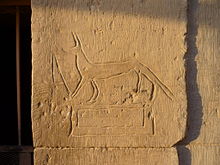
"Graffiti" (usually both singular and plural) and the rare singular form "graffito" are from the Italian word graffiato ("scratched").[6][1][2] The term "graffiti" is used in art history for works of art produced by scratching a design into a surface. A related term is "sgraffito",[7] which involves scratching through one layer of pigment to reveal another beneath it. This technique was primarily used by potters who would glaze their wares and then scratch a design into them. In ancient times graffiti were carved on walls with a sharp object, although sometimes chalk or coal were used. The word originates from Greek γράφειν—graphein—meaning "to write".[8]
History

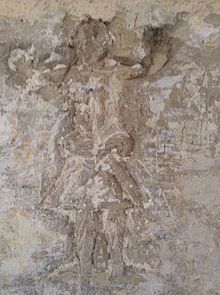
The term graffiti originally referred to the inscriptions, figure drawings, and such, found on the walls of ancient sepulchres or ruins, as in the Catacombs of Rome or at Pompeii. Historically, these writings were not considered vandalism,[9] which today is considered part of the definition of graffiti.[10]
The only known source of the Safaitic language, an ancient form of Arabic, is from graffiti: inscriptions scratched on to the surface of rocks and boulders in the predominantly basalt desert of southern Syria, eastern Jordan and northern Saudi Arabia. Safaitic dates from the first century BC to the fourth century AD.[11][12]
Ancient graffiti
Some of the oldest cave paintings in the world are 40,000 year old ones found in Australia.[9] The oldest written graffiti was found in ancient Rome around 2500 years ago.[13] Most graffiti from the time was boasts about sexual experiences.[14] Graffiti in Ancient Rome was a form of communication, and was not considered vandalism.[9]
Ancient tourists visiting the 5th-century citadel at Sigiriya in Sri Lanka write their names and commentary over the "mirror wall", adding up to over 1800 individual graffiti produced there between the 6th and 18th centuries.[15] Most of the graffiti refer to the frescoes of semi-nude females found there. One reads:
Wet with cool dew drops
fragrant with perfume from the flowers
came the gentle breeze
jasmine and water lily
dance in the spring sunshine
side-long glances
of the golden-hued ladies
stab into my thoughts
heaven itself cannot take my mind
as it has been captivated by one lass
among the five hundred I have seen here.[16]
Among the ancient political graffiti examples were Arab satirist poems. Yazid al-Himyari, an Umayyad Arab and Persian poet, was most known for writing his political poetry on the walls between Sajistan and Basra, manifesting a strong hatred towards the Umayyad regime and its walis, and people used to read and circulate them very widely.[17][clarification needed]
Graffiti, known as Tacherons, were frequently scratched on Romanesque Scandinavian church walls.[18] When Renaissance artists such as Pinturicchio, Raphael, Michelangelo, Ghirlandaio, or Filippino Lippi descended into the ruins of Nero's Domus Aurea, they carved or painted their names and returned to initiate the grottesche style of decoration.[19][20]
There are also examples of graffiti occurring in American history, such as Independence Rock, a national landmark along the Oregon Trail.[21]
- Ancient graffiti
-
Graffiti from the Museum of Ancient Graffiti (fr), France
-
Ironic wall inscription commenting on boring graffiti
-
Satirical Alexamenos graffito, possibly the earliest known representation of Jesus
-
Graffiti, Church of the Holy Sepulchre, Jerusalem
-
Crusader graffiti in the Church of the Holy Sepulchre
Contemporary graffiti
Later, French soldiers carved their names on monuments during the Napoleonic campaign of Egypt in the 1790s.[22] Lord Byron's survives on one of the columns of the Temple of Poseidon at Cape Sounion in Attica, Greece.[23]
The oldest known example of graffiti monikers found on traincars created by hobos and railworkers since the late 1800s. The Bozo Texino monikers were documented by filmmaker Bill Daniel in his 2005 film, Who is Bozo Texino?.[24][25]
In World War II, an inscription on a wall at the fortress of Verdun was seen as an illustration of the US response twice in a generation to the wrongs of the Old World:[26][27]
Austin White – Chicago, Ill – 1918
Austin White – Chicago, Ill – 1945
This is the last time I want to write my name here.
During World War II and for decades after, the phrase "Kilroy was here" with an accompanying illustration was widespread throughout the world, due to its use by American troops and ultimately filtering into American popular culture. Shortly after the death of Charlie Parker (nicknamed "Yardbird" or "Bird"), graffiti began appearing around New York with the words "Bird Lives".[28]
- World War II graffiti
-
Soldier with tropical fantasy graffiti (1943–1944)
- Early spray-painted graffiti
-
New York City Subway trains were covered in graffiti (1973).
-
Graffiti in Chicago (1973)
Modern Graffiti
Modern graffiti art has its origins with young people in 1960s and 70s in New York City and Philadelphia. Tags were the first form of stylised contemporary graffiti. Eventually, throw-ups and pieces evolved with the desire to create larger art. Writers used spray paint and other kind of materials to leave tags or to create images on the sides subway trains.[29] and eventually moved into the city after the NYC metro began to buy new trains and paint over graffiti.[30]
While the art had many advocates and appreciators—including the cultural critic Norman Mailer—others, including New York City mayor Ed Koch, considered it to be defacement of public property, and saw it as a form of public blight.[31] The ‘taggers’ called what they did ‘writing’—though an important 1974 essay by Mailer referred to it using the term ‘graffiti.’[31]
Contemporary graffiti style has been heavily influenced by hip hop culture[32] and the myriad international styles derived from Philadelphia and New York City Subway graffiti; however, there are many other traditions of notable graffiti in the twentieth century. Graffiti have long appeared on building walls, in latrines, railroad boxcars, subways, and bridges.
An early graffito outside of New York or Philadelphia was the inscription in London reading "Clapton is God" in reference to the guitarist Eric Clapton. Creating the cult of the guitar hero, the phrase was spray-painted by an admirer on a wall in Islington, north London, in the autumn of 1967.[33] The graffito was captured in a photograph, in which a dog is urinating on the wall.[34]
Films like Style Wars in the 80s depicting famous writers such as Skeme, Dondi, MinOne, and ZEPHYR reinforced graffiti's role within New York's emerging hip-hop culture. Although many officers of the New York City Police Department found this film to be controversial, Style Wars is still recognized as the most prolific film representation of what was going on within the young hip hop culture of the early 1980s.[35] Fab 5 Freddy and Futura 2000 took hip hop graffiti to Paris and London as part of the New York City Rap Tour in 1983.[36]
Commercialization and entrance into mainstream pop culture
With the popularity and legitimization of graffiti has come a level of commercialization. In 2001, computer giant IBM launched an advertising campaign in Chicago and San Francisco which involved people spray painting on sidewalks a peace symbol, a heart, and a penguin (Linux mascot), to represent "Peace, Love, and Linux." IBM paid Chicago and San Francisco collectively US$120,000 for punitive damages and clean-up costs.[37][38]
In 2005, a similar ad campaign was launched by Sony and executed by its advertising agency in New York, Chicago, Atlanta, Philadelphia, Los Angeles, and Miami, to market its handheld PSP gaming system. In this campaign, taking notice of the legal problems of the IBM campaign, Sony paid building owners for the rights to paint on their buildings "a collection of dizzy-eyed urban kids playing with the PSP as if it were a skateboard, a paddle, or a rocking horse".[38]
Global developments
South America
Tristan Manco wrote that Brazil "boasts a unique and particularly rich, graffiti scene ... [earning] it an international reputation as the place to go for artistic inspiration". Graffiti "flourishes in every conceivable space in Brazil's cities". Artistic parallels "are often drawn between the energy of São Paulo today and 1970s New York". The "sprawling metropolis", of São Paulo has "become the new shrine to graffiti"; Manco alludes to "poverty and unemployment ... [and] the epic struggles and conditions of the country's marginalised peoples", and to "Brazil's chronic poverty", as the main engines that "have fuelled a vibrant graffiti culture". In world terms, Brazil has "one of the most uneven distributions of income. Laws and taxes change frequently". Such factors, Manco argues, contribute to a very fluid society, riven with those economic divisions and social tensions that underpin and feed the "folkloric vandalism and an urban sport for the disenfranchised", that is South American graffiti art.[39]

Prominent Brazilian writers include Os Gêmeos, Boleta, Nunca, Nina, Speto, Tikka, and T.Freak.[40] Their artistic success and involvement in commercial design ventures[41] has highlighted divisions within the Brazilian graffiti community between adherents of the cruder transgressive form of pichação and the more conventionally artistic values of the practitioners of grafite.[42]
Middle East
Graffiti in the Middle East has emerged slowly, with taggers operating in Egypt, Lebanon, the Gulf countries like Bahrain or the United Arab Emirates,[43] Israel, and in Iran. The major Iranian newspaper Hamshahri has published two articles on illegal writers in the city with photographic coverage of Iranian artist A1one's works on Tehran walls. Tokyo-based design magazine, PingMag, has interviewed A1one and featured photographs of his work.[44] The Israeli West Bank barrier has become a site for graffiti, reminiscent in this sense of the Berlin Wall. Many writers in Israel come from other places around the globe, such as JUIF from Los Angeles and DEVIONE from London. The religious reference "נ נח נחמ נחמן מאומן" ("Na Nach Nachma Nachman Meuman") is commonly seen in graffiti around Israel.
Graffiti has played an important role within the street art scene in the Middle East and North Africa (MENA), especially following the events of the Arab Spring of 2011 or the Sudanese Revolution of 2018/19.[45] Graffiti is a tool of expression in the context of conflict in the region, allowing people to raise their voices politically and socially. Famous street artist Banksy has had an important effect in the street art scene in the MENA area, especially in Palestine where some of his works are located in the West Bank barrier and Bethlehem.[46]
Southeast Asia
There are also a large number of graffiti influences in Southeast Asian countries that mostly come from modern Western culture, such as Malaysia, where graffiti have long been a common sight in Malaysia's capital city, Kuala Lumpur. Since 2010, the country has begun hosting a street festival to encourage all generations and people from all walks of life to enjoy and encourage Malaysian street culture.[47]
- Graffiti around the world
-
Graffiti on a wall in Čakovec, Croatia
-
Graffiti in Ho Chi Minh City, Vietnam
-
Graffiti art in Kuala Lumpur, Malaysia
-
Graffiti in Yogyakarta, Indonesia
-
Graffiti on a park wall in Sydney, Australia
-
Graffiti in São Paulo, Brazil
-
Absourdios. Tehran-Iran, 2009.
Types of graffiti
Methods and production
The modern-day graffitists can be found with an arsenal of various materials that allow for a successful production of a piece.[48] This includes such techniques as scribing. However, spray paint in aerosol cans is the number one medium for graffiti. From this commodity comes different styles, technique, and abilities to form master works of graffiti. Spray paint can be found at hardware and art stores and comes in virtually every color.
- Graffiti making
-
Graffiti application at Eurofestival in Turku, Finland
-
A graffiti artist at work in London
Stencil graffiti
Stencil graffiti is created by cutting out shapes and designs in a stiff material (such as cardboard or subject folders) to form an overall design or image. The stencil is then placed on the "canvas" gently and with quick, easy strokes of the aerosol can, the image begins to appear on the intended surface.
Some of the first examples were created in 1981 by artists Blek le Rat in Paris, in 1982 by Jef Aerosol in Tours (France);[49] by 1985 stencils had appeared in other cities including New York City, Sydney, and Melbourne, where they were documented by American photographer Charles Gatewood and Australian photographer Rennie Ellis.[50]
Tagging
Tagging is the practice of someone spray-painting "their name, initial or logo onto a public surface"[51] in a handstyle unique to the writer. Tags were the first form of modern graffiti.
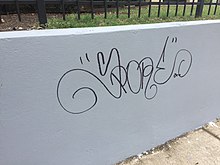
A number of recent examples of graffiti make use of hashtags.[52][53]
Modern experimentation

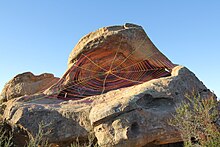
Modern graffiti art often incorporates additional arts and technologies. For example, Graffiti Research Lab has encouraged the use of projected images and magnetic light-emitting diodes (throwies) as new media for graffitists. yarnbombing is another recent form of graffiti. Yarnbombers occasionally target previous graffiti for modification, which had been avoided among the majority of graffitists.
Uses
Theories on the use of graffiti by avant-garde artists have a history dating back at least to the Asger Jorn, who in 1962 painting declared in a graffiti-like gesture "the avant-garde won't give up".[54]
Many contemporary analysts and even art critics have begun to see artistic value in some graffiti and to recognize it as a form of public art. According to many art researchers, particularly in the Netherlands and in Los Angeles, that type of public art is, in fact an effective tool of social emancipation or, in the achievement of a political goal.[55]
In times of conflict, such murals have offered a means of communication and self-expression for members of these socially, ethnically, or racially divided communities, and have proven themselves as effective tools in establishing dialog and thus, of addressing cleavages in the long run. The Berlin Wall was also extensively covered by graffiti reflecting social pressures relating to the oppressive Soviet rule over the GDR.
Many artists involved with graffiti are also concerned with the similar activity of stenciling. Essentially, this entails stenciling a print of one or more colors using spray-paint. Recognized while exhibiting and publishing several of her coloured stencils and paintings portraying the Sri Lankan Civil War and urban Britain in the early 2000s, graffitists Mathangi Arulpragasam, aka M.I.A., has also become known for integrating her imagery of political violence into her music videos for singles "Galang" and "Bucky Done Gun", and her cover art. Stickers of her artwork also often appear around places such as London in Brick Lane, stuck to lamp posts and street signs, she having become a muse for other graffitists and painters worldwide in cities including Seville.
Graffitist believes that art should be on display for everyone in the public eye or in plain sight, not hidden away in a museum or a gallery.[56] Art should color the streets, not the inside of some building. Graffiti is a form of art that cannot be owned or bought. It does not last forever, it is temporary, yet one of a kind. It is a form of self promotion for the artist that can be displayed anywhere from sidewalks, roofs, subways, building wall, etc.[56] Art to them is for everyone and should be showed to everyone for free.
Personal expression
Graffiti is a way of communicating and a way of expressing what one feels in the moment. It is both art and a functional thing that can warn people of something or inform people of something. However, graffiti is to some people a form of art, but to some a form of vandalism.[31] And many graffitists choose to protect their identities and remain anonymous or to hinder prosecution.
With the commercialization of graffiti (and hip hop in general), in most cases, even with legally painted "graffiti" art, graffitists tend to choose anonymity. This may be attributed to various reasons or a combination of reasons. Graffiti still remains the one of four hip hop elements that is not considered "performance art" despite the image of the "singing and dancing star" that sells hip hop culture to the mainstream. Being a graphic form of art, it might also be said that many graffitists still fall in the category of the introverted archetypal artist.
Banksy is one of the world's most notorious and popular street artists who continues to remain faceless in today's society.[57] He is known for his political, anti-war stencil art mainly in Bristol, England, but his work may be seen anywhere from Los Angeles to Palestine. In the UK, Banksy is the most recognizable icon for this cultural artistic movement and keeps his identity a secret to avoid arrest. Much of Banksy's artwork may be seen around the streets of London and surrounding suburbs, although he has painted pictures throughout the world, including the Middle East, where he has painted on Israel's controversial West Bank barrier with satirical images of life on the other side. One depicted a hole in the wall with an idyllic beach, while another shows a mountain landscape on the other side. A number of exhibitions also have taken place since 2000, and recent works of art have fetched vast sums of money. Banksy's art is a prime example of the classic controversy: vandalism vs. art. Art supporters endorse his work distributed in urban areas as pieces of art and some councils, such as Bristol and Islington, have officially protected them, while officials of other areas have deemed his work to be vandalism and have removed it.
Pixnit is another artist who chooses to keep her identity from the general public.[58] Her work focuses on beauty and design aspects of graffiti as opposed to Banksy's anti-government shock value. Her paintings are often of flower designs above shops and stores in her local urban area of Cambridge, Massachusetts. Some store owners endorse her work and encourage others to do similar work as well. "One of the pieces was left up above Steve's Kitchen, because it looks pretty awesome"- Erin Scott, the manager of New England Comics in Allston, Massachusetts.[59]
Graffiti artists may become offended if photographs of their art are published in a commercial context without their permission. In March 2020, the Finnish graffiti artist Psyke expressed his displeasure at the newspaper Ilta-Sanomat publishing a photograph of a Peugeot 208 in an article about new cars, with his graffiti prominently shown on the background. The artist claims he does not want his art being used in commercial context, not even if he were to receive compensation.[60]
- Personal graffiti
-
Drawing at Temple of Philae, Egypt, depicting three men with rods, or staves
-
Inscription in Pompeii lamenting a frustrated love: "Whoever loves, let him flourish, let him perish who knows not love, let him perish twice over whoever forbids love"
-
Post-apocalyptic despair
Territorial
Territorial graffiti marks urban neighborhoods with tags and logos to differentiate certain groups from others. These images are meant to show outsiders a stern look at whose turf is whose. The subject matter of gang-related graffiti consists of cryptic symbols and initials strictly fashioned with unique calligraphies. Gang members use graffiti to designate membership throughout the gang, to differentiate rivals and associates and, most commonly, to mark borders which are both territorial and ideological.[61]
As advertising
Graffiti has been used as a means of advertising both legally and illegally. Bronx-based TATS CRU has made a name for themselves doing legal advertising campaigns for companies such as Coca-Cola, McDonald's, Toyota, and MTV. In the UK, Covent Garden's Boxfresh used stencil images of a Zapatista revolutionary in the hopes that cross referencing would promote their store.
Smirnoff hired artists to use reverse graffiti (the use of high pressure hoses to clean dirty surfaces to leave a clean image in the surrounding dirt) to increase awareness of their product.
- Advertising graffiti
-
Graffiti as legal advertising on a grocer's shop window in Warsaw, Poland
Radical and political

Graffiti often has a reputation as part of a subculture that rebels against authority, although the considerations of the practitioners often diverge and can relate to a wide range of attitudes. It can express a political practice and can form just one tool in an array of resistance techniques. One early example includes the anarcho-punk band Crass, who conducted a campaign of stenciling anti-war, anarchist, feminist, and anti-consumerist messages throughout the London Underground system during the late 1970s and early 1980s.[62] In Amsterdam graffiti was a major part of the punk scene. The city was covered with names such as "De Zoot", "Vendex", and "Dr Rat".[63] To document the graffiti a punk magazine was started that was called Gallery Anus. So when hip hop came to Europe in the early 1980s there was already a vibrant graffiti culture.

The student protests and general strike of May 1968 saw Paris bedecked in revolutionary, anarchistic, and situationist slogans such as L'ennui est contre-révolutionnaire ("Boredom is counterrevolutionary") and Lisez moins, vivez plus ("Read less, live more"). While not exhaustive, the graffiti gave a sense of the 'millenarian' and rebellious spirit, tempered with a good deal of verbal wit, of the strikers.
I think graffiti writing is a way of defining what our generation is like. Excuse the French, we're not a bunch of p---- artists. Traditionally artists have been considered soft and mellow people, a little bit kooky. Maybe we're a little bit more like pirates that way. We defend our territory, whatever space we steal to paint on, we defend it fiercely.
—Sandra "Lady Pink" Fabara[64]
The developments of graffiti art which took place in art galleries and colleges as well as "on the street" or "underground", contributed to the resurfacing in the 1990s of a far more overtly politicized art form in the subvertising, culture jamming, or tactical media movements. These movements or styles tend to classify the artists by their relationship to their social and economic contexts, since, in most countries, graffiti art remains illegal in many forms except when using non-permanent paint. Since the 1990s with the rise of Street Art, a growing number of artists are switching to non-permanent paints and non-traditional forms of painting.[65][66]
Contemporary practitioners, accordingly, have varied and often conflicting practices. Some individuals, such as Alexander Brener, have used the medium to politicize other art forms, and have used the prison sentences enforced on them as a means of further protest.[67] The practices of anonymous groups and individuals also vary widely, and practitioners by no means always agree with each other's practices. For example, the anti-capitalist art group the Space Hijackers did a piece in 2004 about the contradiction between the capitalistic elements of Banksy and his use of political imagery.[68][69]
Berlin human rights activist Irmela Mensah-Schramm has received global media attention and numerous awards for her 35-year campaign of effacing neo-Nazi and other right-wing extremist graffiti throughout Germany, often by altering hate speech in humorous ways.[70][71]

- Political graffiti around the world
-
Graffiti with orthodox cross at the Catholic Church in Ystad, 2021
-
"Revolution". Sweden, 2014.
-
Anti Iraqi war graffiti by street artist Sony Montana in Cancún, Mexico (2007)
-
Wall in Belgrade, Serbia, with the slogan "Vote for Filip Filipović", who was the communist candidate for the mayor of Belgrade (1920)
-
An interpretation of Liberty Leading the People on the separation barrier which runs through Bethlehem
-
WWII bunker near Anhalter Bahnhof (Berlin) with a graffiti inscription Wer Bunker baut, wirft Bomben (those who build bunkers, throw bombs)
-
Graffiti on the train line leading to Central Station in Amsterdam
-
"Let's JOKK" in Tartu refers to political scandal with the Estonian Reform Party (2012).
-
Stencil in Pieksämäki representing former president of Finland, Urho Kekkonen, well known in Finnish popular culture
-
Feminist graffiti in A Coruña, Spain, that reads Enough with rosaries in our ovaries
-
East Timorese protest against Australian petroleum extraction
-
Ironic graffiti in Bethlehem, Palestine
-
Berlin Wall: "Anyone who wants to keep the world as it is, does not want it to remain"
Genocide denial
This article may lend undue weight to certain ideas, incidents, or controversies. (December 2023) |
In Serbian capital, Belgrade, the graffiti depicting a uniformed former general of Serb army and war criminal, convicted at ICTY for war crimes and crimes against humanity, including genocide and ethnic cleansing in Bosnian War, Ratko Mladić, appeared in a military salute alongside the words "General, thank to your mother".[72] Aleks Eror, Berlin-based journalist, explains how "veneration of historical and wartime figures" through street art is not a new phenomenon in the region of former Yugoslavia, and that "in most cases is firmly focused on the future, rather than retelling the past".[73] Eror is not only analyst pointing to danger of such an expressions for the region's future. In a long expose on the subject of Bosnian genocide denial, at Balkan Diskurs magazine and multimedia platform website, Kristina Gadže and Taylor Whitsell referred to these experiences as a young generations' "cultural heritage", in which young are being exposed to celebration and affirmation of war-criminals as part of their "formal education" and "inheritance".[74]

There are numerous examples of genocide denial through celebration and affirmation of war criminals throughout the region of Western Balkans inhabited by Serbs using this form of artistic expression. Several more of these graffiti are found in Serbian capital, and many more across Serbia and Bosnian and Herzegovinian administrative entity, Republika Srpska, which is the ethnic Serbian majority enclave.[73][75] Critics point that Serbia as a state, is willing to defend the mural of convicted war criminal, and have no intention to react on cases of genocide denial, noting that Interior Minister of Serbia, Aleksandar Vulin decision to ban any gathering with an intent to remove the mural, with the deployment of riot police, sends the message of "tacit endorsement".[72][76] Consequently, on 9 November 2021, Serbian heavy police in riot gear, with graffiti creators and their supporters,[74] blocked the access to the mural to prevent human rights groups and other activists to paint over it and mark the International Day Against Fascism and Antisemitism in that way,[72] and even arrested two civic activist for throwing eggs at the graffiti.[76]
Offensive graffiti

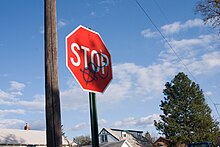
Graffiti may also be used as an offensive expression. This form of graffiti may be difficult to identify, as it is mostly removed by the local authority (as councils which have adopted strategies of criminalization also strive to remove graffiti quickly).[77] Therefore, existing racist graffiti is mostly more subtle and at first sight, not easily recognized as "racist". It can then be understood only if one knows the relevant "local code" (social, historical, political, temporal, and spatial), which is seen as heteroglot and thus a 'unique set of conditions' in a cultural context.[78]
- A spatial code for example, could be that there is a certain youth group in an area that is engaging heavily in racist activities. So, for residents (knowing the local code), a graffiti containing only the name or abbreviation of this gang already is a racist expression, reminding the offended people of their gang activities. Also a graffiti is in most cases, the herald of more serious criminal activity to come.[79] A person who does not know these gang activities would not be able to recognize the meaning of this graffiti. Also if a tag of this youth group or gang is placed on a building occupied by asylum seekers, for example, its racist character is even stronger.
By making the graffiti less explicit (as adapted to social and legal constraints),[80] these drawings are less likely to be removed, but do not lose their threatening and offensive character.[81]
Elsewhere, activists in Russia have used painted caricatures of local officials with their mouths as potholes, to show their anger about the poor state of the roads.[82] In Manchester, England, a graffitists painted obscene images around potholes, which often resulted in them being repaired within 48 hours.[83]
Decorative and high art
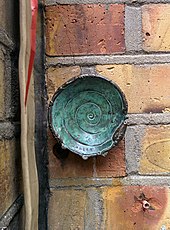
In the early 1980s, the first art galleries to show graffitists to the public were Fashion Moda in the Bronx, Now Gallery and Fun Gallery, both in the East Village, Manhattan.[84][85][86][87]
A 2006 exhibition at the Brooklyn Museum displayed graffiti as an art form that began in New York's outer boroughs and reached great heights in the early 1980s with the work of Crash, Lee, Daze, Keith Haring, and Jean-Michel Basquiat. It displayed 22 works by New York graffitists, including Crash, Daze, and Lady Pink. In an article about the exhibition in the magazine Time Out, curator Charlotta Kotik said that she hoped the exhibition would cause viewers to rethink their assumptions about graffiti.
From the 1970s onwards, Burhan Doğançay photographed urban walls all over the world; these he then archived for use as sources of inspiration for his painterly works. The project today known as "Walls of the World" grew beyond even his own expectations and comprises about 30,000 individual images. It spans a period of 40 years across five continents and 114 countries. In 1982, photographs from this project comprised a one-man exhibition titled "Les murs murmurent, ils crient, ils chantent ..." (The walls whisper, shout and sing ...) at the Centre Georges Pompidou in Paris.
In Australia, art historians have judged some local graffiti of sufficient creative merit to rank them firmly within the arts. Oxford University Press's art history text Australian Painting 1788–2000 concludes with a long discussion of graffiti's key place within contemporary visual culture, including the work of several Australian practitioners.[88]
Between March and April 2009, 150 artists exhibited 300 pieces of graffiti at the Grand Palais in Paris.[89][90]
- Street art graffiti
-
Graffiti in Buenos Aires, showing the Obelisk
-
Graffiti on a wall in Budapest, Hungary
Environmental effects
Spray paint has many negative environmental effects. The paint contains toxic chemicals, and the can uses volatile hydrocarbon gases to spray the paint onto a surface.[91]
Volatile organic compound (VOC) leads to ground level ozone formation and most of graffiti related emissions are VOCs.[92] A 2010 paper estimates 4,862 tons of VOCs were released in the United States in activities related to graffiti.[92][93]
Government responses
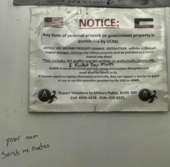
Asia
In China, Mao Zedong in the 1920s used revolutionary slogans and paintings in public places to galvanize the country's communist movement.[94]
Based on different national conditions, many people believe that China's attitude towards Graffiti is fierce, but in fact, according to Lance Crayon in his film Spray Paint Beijing: Graffiti in the Capital of China, Graffiti is generally accepted in Beijing, with artists not seeing much police interference. Political and religiously sensitive graffiti, however, is not allowed.[95]
In Hong Kong, Tsang Tsou Choi was known as the King of Kowloon for his calligraphy graffiti over many years, in which he claimed ownership of the area. Now some of his work is preserved officially.
In Taiwan, the government has made some concessions to graffitists. Since 2005 they have been allowed to freely display their work along some sections of riverside retaining walls in designated "Graffiti Zones".[96] From 2007, Taipei's department of cultural affairs also began permitting graffiti on fences around major public construction sites. Department head Yong-ping Lee (李永萍) stated, "We will promote graffiti starting with the public sector, and then later in the private sector too. It's our goal to beautify the city with graffiti". The government later helped organize a graffiti contest in Ximending, a popular shopping district. Graffitists caught working outside of these designated areas still face fines up to NT$6,000 under a department of environmental protection regulation.[97] However, Taiwanese authorities can be relatively lenient, one veteran police officer stating anonymously, "Unless someone complains about vandalism, we won't get involved. We don't go after it proactively."[98]
In 1993, after several expensive cars in Singapore were spray-painted, the police arrested a student from the Singapore American School, Michael P. Fay, questioned him, and subsequently charged him with vandalism. Fay pleaded guilty to vandalizing a car in addition to stealing road signs. Under the 1966 Vandalism Act of Singapore, originally passed to curb the spread of communist graffiti in Singapore, the court sentenced him to four months in jail, a fine of S$3,500 (US$2,233), and a caning. The New York Times ran several editorials and op-eds that condemned the punishment and called on the American public to flood the Singaporean embassy with protests. Although the Singapore government received many calls for clemency, Fay's caning took place in Singapore on 5 May 1994. Fay had originally received a sentence of six strokes of the cane, but the presiding president of Singapore, Ong Teng Cheong, agreed to reduce his caning sentence to four lashes.[99]
In South Korea, Park Jung-soo was fined two million South Korean won by the Seoul Central District Court for spray-painting a rat on posters of the G-20 Summit a few days before the event in November 2011. Park alleged that the initial in "G-20" sounds like the Korean word for "rat", but Korean government prosecutors alleged that Park was making a derogatory statement about the president of South Korea, Lee Myung-bak, the host of the summit. This case led to public outcry and debate on the lack of government tolerance and in support of freedom of expression. The court ruled that the painting, "an ominous creature like a rat" amounts to "an organized criminal activity" and upheld the fine while denying the prosecution's request for imprisonment for Park.[100]
- Graffiti in Asia
-
Street graffiti in Hong Kong
Europe
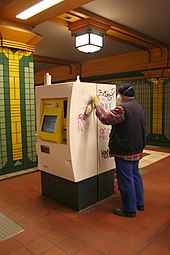
In Europe, community cleaning squads have responded to graffiti, in some cases with reckless abandon, as when in 1992 in France a local Scout group, attempting to remove modern graffiti, damaged two prehistoric paintings of bison in the Cave of Mayrière supérieure near the French village of Bruniquel in Tarn-et-Garonne, earning them the 1992 Ig Nobel Prize in archeology.[101]
In September 2006, the European Parliament directed the European Commission to create urban environment policies to prevent and eliminate dirt, litter, graffiti, animal excrement, and excessive noise from domestic and vehicular music systems in European cities, along with other concerns over urban life.[102]
In Budapest, Hungary, both a city-backed movement called I Love Budapest and a special police division tackle the problem, including the provision of approved areas.[103]
United Kingdom
The Anti-social Behaviour Act 2003 became Britain's latest anti-graffiti legislation. In August 2004, the Keep Britain Tidy campaign issued a press release calling for zero tolerance of graffiti and supporting proposals such as issuing "on the spot" fines to graffiti offenders and banning the sale of aerosol paint to anyone under the age of 16.[104] The press release also condemned the use of graffiti images in advertising and in music videos, arguing that real-world experience of graffiti stood far removed from its often-portrayed "cool" or "edgy'" image.
To back the campaign, 123 Members of Parliament (MPs) (including then Prime Minister Tony Blair), signed a charter which stated: "Graffiti is not art, it's crime. On behalf of my constituents, I will do all I can to rid our community of this problem."[105]
In the UK, city councils have the power to take action against the owner of any property that has been defaced under the Anti-social Behaviour Act 2003 (as amended by the Clean Neighbourhoods and Environment Act 2005) or, in certain cases, the Highways Act. This is often used against owners of property that are complacent in allowing protective boards to be defaced so long as the property is not damaged.[citation needed]
In July 2008, a conspiracy charge was used to convict graffitists for the first time. After a three-month police surveillance operation,[106] nine members of the DPM crew were convicted of conspiracy to commit criminal damage costing at least £1 million. Five of them received prison sentences, ranging from eighteen months to two years. The unprecedented scale of the investigation and the severity of the sentences rekindled public debate over whether graffiti should be considered art or crime.[107]
Some councils, like those of Stroud and Loerrach, provide approved areas in the town where graffitists can showcase their talents, including underpasses, car parks, and walls that might otherwise prove a target for the "spray and run".[108]
- Graffiti in Europe
-
Multi-artist graffiti in Barcelona, Spain
-
Integration of graffiti into its environment, Zumaia, Spain (2016)
-
Graffiti made by school children in Rijeka, Croatia
-
Graffiti written in Georgian script, Tbilisi, Georgia
-
Historical graffito of Gavrilo Princip in Belgrade, Serbia
-
Graffiti on a garage near a school in Nizhny Novgorod, Russia
Australia
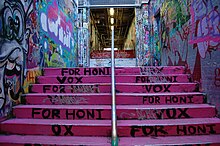
In an effort to reduce vandalism, many cities in Australia have designated walls or areas exclusively for use by graffitists. One early example is the "Graffiti Tunnel" located at the Camperdown Campus of the University of Sydney, which is available for use by any student at the university to tag, advertise, poster, and paint. Advocates of this idea suggest that this discourages petty vandalism yet encourages artists to take their time and produce great art, without worry of being caught or arrested for vandalism or trespassing.[109][110] Others disagree with this approach, arguing that the presence of legal graffiti walls does not demonstrably reduce illegal graffiti elsewhere.[111] Some local government areas throughout Australia have introduced "anti-graffiti squads", who clean graffiti in the area, and such crews as BCW (Buffers Can't Win) have taken steps to keep one step ahead of local graffiti cleaners.
Many state governments have banned the sale or possession of spray paint to those under the age of 18 (age of majority). However, a number of local governments in Victoria have taken steps to recognize the cultural heritage value of some examples of graffiti, such as prominent political graffiti. Tough new graffiti laws have been introduced in Australia with fines of up to A$26,000 and two years in prison.
Melbourne is a prominent graffiti city of Australia with many of its lanes being tourist attractions, such as Hosier Lane in particular, a popular destination for photographers, wedding photography, and backdrops for corporate print advertising. The Lonely Planet travel guide cites Melbourne's street as a major attraction. All forms of graffiti, including sticker art, poster, stencil art, and wheatpasting, can be found in many places throughout the city. Prominent street art precincts include; Fitzroy, Collingwood, Northcote, Brunswick, St. Kilda, and the CBD, where stencil and sticker art is prominent. As one moves farther away from the city, mostly along suburban train lines, graffiti tags become more prominent. Many international artists such as Banksy have left their work in Melbourne and in early 2008 a perspex screen was installed to prevent a Banksy stencil art piece from being destroyed, it has survived since 2003 through the respect of local street artists avoiding posting over it, although it has recently had paint tipped over it.[112]
New Zealand
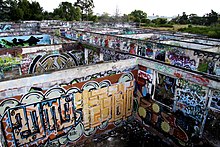
In February 2008 Helen Clark, the New Zealand prime minister at that time, announced a government crackdown on tagging and other forms of graffiti vandalism, describing it as a destructive crime representing an invasion of public and private property. New legislation subsequently adopted included a ban on the sale of paint spray cans to persons under 18 and increases in maximum fines for the offence from NZ$200 to NZ$2,000 or extended community service. The issue of tagging become a widely debated one following an incident in Auckland during January 2008 in which a middle-aged property owner stabbed one of two teenage taggers to death and was subsequently convicted of manslaughter.
United States
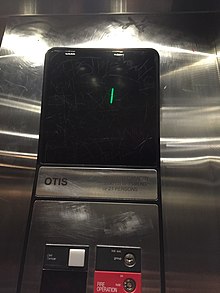
Tracker databases
Graffiti databases have increased in the past decade because they allow vandalism incidents to be fully documented against an offender and help the police and prosecution charge and prosecute offenders for multiple counts of vandalism. They also provide law enforcement the ability to rapidly search for an offender's moniker or tag in a simple, effective, and comprehensive way. These systems can also help track costs of damage to a city to help allocate an anti-graffiti budget. The theory is that when an offender is caught putting up graffiti, they are not just charged with one count of vandalism; they can be held accountable for all the other damage for which they are responsible. This has two main benefits for law enforcement. One, it sends a signal to the offenders that their vandalism is being tracked. Two, a city can seek restitution from offenders for all the damage that they have committed, not merely a single incident. These systems give law enforcement personnel real-time, street-level intelligence that allows them not only to focus on the worst graffiti offenders and their damage, but also to monitor potential gang violence that is associated with the graffiti.[113]
Gang injunctions
Many restrictions of civil gang injunctions are designed to help address and protect the physical environment and limit graffiti. Provisions of gang injunctions include things such as restricting the possession of marker pens, spray paint cans, or other sharp objects capable of defacing private or public property; spray painting, or marking with marker pens, scratching, applying stickers, or otherwise applying graffiti on any public or private property, including, but not limited to the street, alley, residences, block walls, and fences, vehicles or any other real or personal property. Some injunctions contain wording that restricts damaging or vandalizing both public and private property, including but not limited to any vehicle, light fixture, door, fence, wall, gate, window, building, street sign, utility box, telephone box, tree, or power pole.[114]
Hotlines and reward programs
To help address many of these issues, many local jurisdictions have set up graffiti abatement hotlines, where citizens can call in and report vandalism and have it removed. San Diego's hotline receives more than 5,000 calls per year, in addition to reporting the graffiti, callers can learn more about prevention. One of the complaints about these hotlines is the response time; there is often a lag time between a property owner calling about the graffiti and its removal. The length of delay should be a consideration for any jurisdiction planning on operating a hotline. Local jurisdictions must convince the callers that their complaint of vandalism will be a priority and cleaned off right away. If the jurisdiction does not have the resources to respond to complaints in a timely manner, the value of the hotline diminishes. Crews must be able to respond to individual service calls made to the graffiti hotline as well as focus on cleanup near schools, parks, and major intersections and transit routes to have the biggest impact. Some cities offer a reward for information leading to the arrest and prosecution of suspects for tagging or graffiti related vandalism. The amount of the reward is based on the information provided, and the action taken.[115]
Search warrants
When police obtain search warrants in connection with a vandalism investigation, they are often seeking judicial approval to look for items such as cans of spray paint and nozzles from other kinds of aerosol sprays; etching tools, or other sharp or pointed objects, which could be used to etch or scratch glass and other hard surfaces; permanent marking pens, markers, or paint sticks; evidence of membership or affiliation with any gang or tagging crew; paraphernalia including any reference to "(tagger's name)"; any drawings, writing, objects, or graffiti depicting taggers' names, initials, logos, monikers, slogans, or any mention of tagging crew membership; and any newspaper clippings relating to graffiti crime.[116]
- Graffiti in the United States
-
Rampant graffiti hampers visibility into and out of New York City Subway cars (1973).
-
Graffiti-lined tunnel in San Francisco
-
Graffiti in Los Angeles (2006)
-
Anti-governmental graffiti in Bolinas, California
-
Protest art in Memphis, Tennessee
-
Graffiti in Cortlandt Alley, Tribeca, Lower Manhattan (2023)
Documentaries
- 80 Blocks from Tiffany's (1979), a rare glimpse of the late 1970s in New York City toward the end of the notorious South Bronx gangs, the documentary shows many aspects of the South Bronx's predominantly Puerto Rican community, including reformed gang members, current gang members, the police, and the community leaders who try to reach out to them.
- Stations of the Elevated (1980), the earliest documentary about subway graffiti in New York City, with music by Charles Mingus
- Style Wars (1983), an early documentary on hip hop culture, made in New York City
- Piece by Piece (2005), a feature-length documentary on the history of San Francisco graffiti from the early 1980s
- Infamy (2005), a feature-length documentary about graffiti culture as told through the experiences of six well-known graffiti writers and a graffiti buffer
- NEXT: A Primer on Urban Painting (2005), a documentary about global graffiti culture
- RASH (2005), a feature documentary about Melbourne, Australia, and the artists who make it a living host for street art
- Jisoe (2007), a glimpse into the life of a Melbourne, Australia, graffiti writer shows the audience an example of graffiti in struggling Melbourne Areas.
- Roadsworth: Crossing the Line (2009), about Montréal artist Peter Gibson and his controversial stencil art on public roads
- Exit Through The Gift Shop (2010) was produced by the notorious artist Banksy. It tells the story of Thierry Guetta, a French immigrant in Los Angeles, and his obsession with street art; Shepard Fairey and Invader, whom Guetta discovers is his cousin, are also in the film.
- Still on and non the wiser (2011) is a ninety-minute-long documentation that accompanies the exhibition with the same name in the Kunsthalle Barmen of the Von der Heydt-Museum in Wuppertal (Germany). It draws vivid portrayals of the artists by means of very personal interviews and also catches the creation process of the works before the exhibition was opened.[117]
- Graffiti Wars (2011), a documentary detailing King Robbo's feud with Banksy as well as the authorities' differing attitude towards graffiti and street art[118]
Dramas
- Wild Style (1983), about hip hop and graffiti culture in New York City
- Turk 182 (1985), about graffiti as political activism
- Bomb the System (2002), about a crew of graffitists in modern-day New York City
- Quality of Life (2004) was shot in the Mission District of San Francisco, co-written by and starring a retired graffiti writer.
- Wholetrain (2006), a German film
-
Bristol_UK_graffiti_art3
-
Bristol city centre wall graffiti
See also
References
- ^ a b "Graffiti". Oxford Dictionaries. Archived from the original on December 19, 2010. Retrieved 5 December 2011.
- ^ a b Publishers, HarperCollins. "The American Heritage Dictionary entry: graffiti". www.ahdictionary.com. Retrieved 2024-03-26.
- ^ "Graffito". Oxford English Dictionary. Vol. 2. Oxford University Press. 2006.
- ^ "Why Gang Graffiti Is Dangerous—Los Angeles Police Department". www.lapdonline.org. Archived from the original on 20 February 2018. Retrieved 19 February 2018.
- ^ Caves, R. W. (2004). Encyclopedia of the City. Routledge. p. 315.
- ^ The Italian singular form "graffito" is so rare in English (except in specialist texts on archeology) that it is not even recorded or mentioned in some dictionaries, for example the Longman Dictionary of Contemporary English and the Cambridge Advanced Learner's Dictionary.
- ^ Grant, Alison (1983). North Devon Pottery: The Seventeenth Century. University of Exeter Press. pp. 1–2.
- ^ "graffiti | Origin and meaning of graffiti by Online Etymology Dictionary". www.etymonline.com. Retrieved 19 February 2018.
- ^ a b c McDonald, Fiona (2013-06-13). The Popular History of Graffiti: From the Ancient World to the Present. Simon and Schuster. ISBN 978-1-62636-291-8.
- ^ "How Old Is Graffiti?". Wonderopolis. Retrieved 24 January 2017.
- ^ dan. "Ancient Arabia: Languages and Cultures—Safaitic Database Online". krc2.orient.ox.ac.uk. Archived from the original on 20 February 2018. Retrieved 19 February 2018.
- ^ dan. "The Online Corpus of the Inscriptions of Ancient North Arabia—Safaitic". krc.orient.ox.ac.uk. Archived from the original on 20 February 2018. Retrieved 19 February 2018.
- ^ Magazine, Smithsonian; Griggs, Mary Beth. "Archaeologists in Greece Find Some of the World's Oldest Erotic Graffiti". Smithsonian Magazine. Retrieved 2023-09-03.
- ^ Smith, Helena (2014-07-06). "2,500-year-old erotic graffiti found in unlikely setting on Aegean island". The Guardian. ISSN 0261-3077. Retrieved 2023-09-03.
- ^ Kljun, Matjaž; Pucihar, Klen Čopič (2015). ""I Was Here": Enabling Tourists to Leave Digital Graffiti or Marks on Historic Landmarks". In Abascal, Julio; Barbosa, Simone; Fetter, Mirko; Gross, Tom; Palanque, Philippe; Winckler, Marco (eds.). Human-Computer Interaction – INTERACT 2015. Lecture Notes in Computer Science. Vol. 9299. Cham: Springer International Publishing. pp. 490–494. doi:10.1007/978-3-319-22723-8_45. ISBN 978-3-319-22723-8.
- ^ Paranavithana, Senarath (1956). Sigiri Graffiti; Being Sinhalese Verses of the Eighth, Ninth and Tenth Centuries. London: Govt. of Ceylon by Oxford UP.
- ^ حسين مروّة، تراثنا كيف نعرفه، مؤسسة الأبحاث العربية، بيروت، 1986[clarification needed]
- ^ "Tacherons on Romanesque churches" (PDF). Archived (PDF) from the original on 2007-08-10.
- ^ British Archaeology, June 1999
- ^ "Underground Rome". The Atlantic Monthly. April 1997.
- ^ "Independence Rock—California National Historic Trail (National Park Service)". National Park Service. Retrieved 18 January 2018.
- ^ "Art Crimes". Jinx Magazine. Archived from the original on 14 October 2014.
- ^ Shanks, Michael (1996). Classical Archaeology of Greece: Experiences of the Discipline. London, New York: Routledge. p. 76. ISBN 978-0-415-08521-2.
- ^ Daniel, Bill (22 July 2010). "Who Is Bozo Texino?". Retrieved 23 August 2018.
- ^ Daniel, Bill (2005). "Who Is Bozo Texino?". Who Is Bozo Texino? The Secret History of Hobo Graffiti. Retrieved 23 August 2018.
- ^ Reagan, Geoffrey (1992). Military Anecdotes (1992). Guinness Publishing. p. 33. ISBN 978-0-85112-519-0.
- ^ "Words From a War". The New York Times. 14 August 1985. Retrieved 2 January 2017.
- ^ Russell, Ross. Bird Lives!: The High Life And Hard Times Of Charlie (yardbird) Parker. Da Capo Press.
- ^ Tate. "Graffiti art". Tate. Retrieved 2023-02-23.
- ^ Snyder, Gregory J. (2006-04-01). "Graffiti media and the perpetuation of an illegal subculture". Crime, Media, Culture. 2 (1): 93–101. doi:10.1177/1741659006061716. ISSN 1741-6590. S2CID 144911784.
- ^ a b c "The history of graffiti". learnenglishteens.britishcouncil.org. Retrieved 2023-03-24.
- ^ Edwards, Paul (10 February 2015). "Is Graffiti Really An Element Of Hip-Hop? (book excerpt)". The Concise Guide to Hip-Hop Music. Retrieved 23 August 2018.
- ^ Hann, Michael (12 June 2011). "Eric Clapton creates the cult of the guitar hero". The Guardian. Archived from the original on 11 March 2017. Retrieved 16 December 2016.
- ^ McCormick, Neil (24 July 2015). "Just how good is Eric Clapton?". The Telegraph. London. Archived from the original on 24 November 2017. Retrieved 3 April 2018.
- ^ Labonte, Paul. All City: The book about taking space. Toronto. ECW Press. 2003
- ^ David Hershkovits, "London Rocks, Paris Burns and the B-Boys Break a Leg", Sunday News Magazine, 3 April 1983.
- ^ Niccolai, James (19 April 2001). "IBM's graffiti ads run afoul of city officials". CNN. Archived from the original on 4 October 2006. Retrieved 11 October 2006.
- ^ a b "Sony Draws Ire With PSP Graffiti". Wired. 5 December 2005. Retrieved 8 April 2008.
- ^ Manco, Tristan (2005). Lost Art & Caleb Neelon, Graffiti Brazil. London: Thames and Hudson. pp. 7–10.
- ^ "A força do novo grafite". Marie Claire (in Portuguese). Archived from the original on 29 November 2014. Retrieved 19 November 2014.
- ^ "Nunca x Nike Sportswear "Team Brazil" Pack". Nicekicks.com. 17 February 2010. Archived from the original on 26 April 2011. Retrieved 22 November 2010.
- ^ "Pintando o muro". Revelacaoonline.uniube.br. Archived from the original on 1 May 2011.
- ^ Zoghbi, Pascal; Stone; Hawley, Joy (2013). Arabic graffiti = Ghirāfītī ʻArabīyah. Berlin: From Here to Fame. ISBN 978-3-937946-45-0. OCLC 818463305.
- ^ Uleshka (19 January 2005). "A1one: 1st generation Graffiti in Iran". PingMag. Archived from the original on 22 February 2008.
- ^ "Bashir's Overthrow Inspires Sudan Graffiti Artists". Asharq AL-awsat. Retrieved 2021-06-29.
- ^ DeTruk, Sabrina (2015). "The "Banksy Effect" and Street Art in the Middle East". SAUC – Street Art & Urban Creativity Scientific Journal. 1 (2): 22–30.
- ^ "Graffiti competition in Kuala Lumpur draws local and international artists". Khabar Southeast Asia. 15 February 2012. Archived from the original on 13 November 2012. Retrieved 17 April 2012.
- ^ Ganz, Nicolas (2004). Graffiti World. New York. Abrams.
- ^ "The Evolution of Graffiti Art". Arts Fiesta. 2024-04-11. Retrieved 2024-04-13.
- ^ Ellis, Rennie (1985). The All New Australian Graffiti. Sun Books, Melbourne. ISBN 978-0-7251-0484-9.
- ^ "Gullu Daley, Ajax Watson and Jestina Sharpe depicted in St Paul's street art". BBC News. 2022-01-18. Retrieved 2022-01-19.
- ^ "Hashtag on the pavement connects with Fitzrovia's past". Fitzrovia News. 2015-07-23. Retrieved 2024-03-26.
- ^ "#RISKROCK #GRAFFITI IN #SANFRANCISCO". Mass Appeal. Archived from the original on 2017-10-11.
- ^ Karen Kurczynski (2008). Expression as vandalism: Asger Jorn's "Modifications". The University of Chicago Press. p. 293.
- ^ Martin Thiele; Sally Marsden (25 January 2002). "P(ART)icipation and Social Change (.doc file)". Archived from the original (DOC) on 15 June 2005. Retrieved 11 October 2006.
- ^ a b "Street and Graffiti Art Movement Overview". The Art Story. Retrieved 2023-03-24.
- ^ Banksy (2005). Wall and Piece. New York: Random House UK. ISBN 9781844137862.
- ^ Shaer, Matthew (3 January 2007). "Pixnit Was Here". The Boston Globe. Retrieved 1 March 2009.
- ^ "Pixnit was here | Stencil Archive". www.stencilarchive.org. Retrieved 2021-06-03.
- ^ Tamminen, Jari: Kuka omistaa graffitin? In Voima issue #1/2021, p. 40.
- ^ Ley, David; Roman Cybriwsky (Dec 1974). "Urban Graffiti as Territorial Markers".
- ^ "Crass Discography (Christ's reality asylum)". Southern Records. Archived from the original on 12 September 2006. Retrieved 11 October 2006.
- ^ Kimvall, Jacob (7 October 2007). "SFT: Ny dokumentär reder ut graffitins punkiga rötter" (in Swedish).. Dr Rat died in 1981 of an overdose at the age of 20 and was somewhat of an underground hero.
- ^ Chang, Jeff (2005). Can't Stop Won't Stop: A History of the Hip-Hop Generation. New York: St. Martin's Press. p. 124. ISBN 978-0-312-30143-9.
- ^ HARRINGTON, STEVEN. "Temporary Street Art That's Changing The Graffiti Game". Ziptopia. Retrieved 26 August 2018.
- ^ English, Ron (6 December 2017). "Street Art: It's Not Meant to be Permanent". Huffington Post. Retrieved 26 August 2018.
- ^ "Border Crossings". Village Voice. 1 August 2000. Archived from the original on 7 November 2006. Retrieved 11 October 2006.
- ^ "Banksy". Tanya Baxter Contemporary Gallery. Retrieved 26 August 2018.
- ^ "Banksy". Haynes Fine Art. Retrieved 26 August 2018.
- ^ Ramsel, Yannick (8 January 2021). "Die Hakenkreuzjägerin". Der Spiegel.
- ^ Cataneo, Emily (12 April 2018). "The Berliner Who Evaded Arrest". Off Assignment.
- ^ a b c Nevena Bogdanović; Predrag Urošević; Andy Heil (November 10, 2021). "Graffiti War: Battle In The Streets Over Ratko Mladic Mural". Radio Free Europe / Radio Liberty. Belgrade. Retrieved 28 August 2022.
- ^ a b Aleks Eror (14 December 2021). "How Serbian street art is using the past to shape the future". The Calvert Journal. Retrieved 28 August 2022.
- ^ a b Taylor Whitsell; Kristina Gadže (15 December 2021). "New Generations Still Follow in a War Criminal's Footsteps". Balkan Diskurs. Belgrade. Retrieved 28 August 2022.
- ^ Dženana Karup-Druško (16 May 2019). "Denying genocide and celebrating war criminals may only be stopped by the adoption of a law that sanctions the actions". Heinrich-Böll-Stiftung. Sarajevo. Retrieved 28 August 2022.
- ^ a b Sofija Popović (12 November 2021). "The case of Mladić mural shows that authorities in Serbia have no intention to deal with war crimes". European Western Balkans. Belgrade. Retrieved 28 August 2022.
- ^ Halsey, M.; Young, A. (2002). "The Meanings of Graffiti and Municipal Administration". Australian and New Zealand Journal of Criminology. 35 (2): 165–86. doi:10.1375/acri.35.2.165. S2CID 145251151.
- ^ Holquist, M. (1981). "Glossary". In Bakhtin, M.M. (ed.). The Dialogic Imagination. Austin: University of Texas Press. p. 423.
- ^ Kelling, G.; Coles, C. (1996). Fixing Broken Windows. New York: Martin Kessler Books.
- ^ Barker, M. (1981). The New Racism. London: Junction Books.
- ^ Lynn, Nick; Lea, Susan J. (2005). "'Racist' graffiti: text, context and social comment". Visual Communication. 4: 39–63. doi:10.1177/1470357205048935. S2CID 145493422.
- ^ Schreck, Carl (19 June 2015). "Russian politicians mocked with guerrilla pothole portraits". New East Network. Retrieved 24 September 2015.
- ^ "Meet the man using penises to fill potholes". The Telegraph. 29 April 2015. Archived from the original on 2022-01-11. Retrieved 24 September 2015.
- ^ diallo, David (2014). "From the Street to Art Galleries : How Graffiti Became a Legitimate Art Form". Open Edition. Retrieved 26 August 2018.
- ^ Morgan, Tiernan (6 August 2015). "35 Years After Fashion Moda, a Bronx Gallery Revisits the Landmark Space". Hyperallergic. Retrieved 26 August 2018.
- ^ HODARA, SUSAN (23 March 2012). "When a South Bronx Collective Went International". New York Times. Archived from the original on 2022-01-02. Retrieved 26 August 2018.
- ^ SAMUELS, TANYANIKA (15 February 2013). "The legacy of Fashion Moda, a shuttered art and performance space, to be spotlighted". New York Daily News. Retrieved 26 August 2018.
- ^ Smith, Bernard William; Smith, Terry; Heathcote, Christopher (2001). Australian Painting 1788–2000. Oxford University Press.
- ^ "RFI—Graffiti gets into the Grand Palais". Rfi.fr. Archived from the original on 19 November 2009. Retrieved 29 July 2010.
- ^ Rohter, Larry (30 March 2009). "Toasting Graffiti Artists". The New York Times. Retrieved 2 April 2010.
- ^ "Health and Environmental Issues of Spray Paint". Healthcare Environmental Resource Center. Retrieved 30 April 2019.
- ^ a b Leskys, AM (September 2010). "Establishing Graffiti Emissions as a Nonpoint Source Sector" (PDF). Archived (PDF) from the original on 2011-02-04.
- ^ "19th International Emission Inventory Conference "Emission Inventories—Informing Emerging Issues" September 2010". EPA.
- ^ "In pictures: Graffiti artists in Beijing, Graffiti tradition". BBC News.
- ^ "Beijing's thriving graffiti culture may surprise you". Public Radio International. Retrieved 24 April 2019.
- ^ Mo, Yan-chih (13 August 2007). "FEATURE: Taipei's graffiti artists strive for greater acceptance". Taipei Times. Retrieved 16 January 2011.
- ^ "Taipei targets graffiti". Taipei Times. 8 June 2009. Retrieved 16 January 2011.
- ^ Jennings, Ralph (25 September 2008). "Taiwan graffiti artist colors in legal gray area". Reuters. Retrieved 16 January 2011.[permanent dead link]
- ^ Shenon, Philip (8 May 1994). "Singapore Swings; Michael Fay's Torture's Over; Watch for the Docudrama". New York Times. Retrieved 2 April 2010.
- ^ Woo, Jaeyeon (31 May 2011). "Rat Graffiti Becomes a Political Stew". Korea Real Time (Wall Street Journal). Dow Jones & Company, Inc. Retrieved 6 June 2011.
- ^ "1992 Ig Nobel Prize Winners". Archived from the original on 25 February 2011.
- ^ "Texts adopted - Thematic strategy on the urban environment - Tuesday, 26 September 2006". www.europarl.europa.eu.
- ^ "Index—Belföld—Kommandó üldözi a graffitiseket". Index.hu. 14 March 2010. Retrieved 29 July 2010.
- ^ "Graffiti" (Press release). EnCams.
- ^ "Is the Writing on the Wall for Graffiti". PR News Wire. 28 July 2004.
- ^ "Jail for leader of graffiti gang". BBC News. 11 July 2008. Retrieved 17 July 2008.
- ^ Akbar, Arifa; Paul Vallely (16 July 2008). "Graffiti: Street art—or crime?". The Independent. London. Retrieved 17 July 2008.
- ^ "Graffiti? Or is it Art?". BBC Gloucestershire.
- ^ "Legal Graffiti Wall Rules". Warringah Council. Archived from the original on 21 August 2006. Retrieved 25 August 2006.
- ^ "Newcastle beach to get 'legal graffiti' wall". ABC News Online. 25 May 2005. Archived from the original on 29 April 2011. Retrieved 9 December 2018.
- ^ "Against the wall". North Shore:Towns Online.com. 11 August 2006.[permanent dead link]
- ^ "The painter painted: Melbourne loses its treasured Banksy". 13 December 2008. Retrieved 30 June 2009.
- ^ "Chapter 8". Introduction to Criminal Investigation. Editor(s) Michael Birzer and Cliff Roberson.
- ^ O'Deane, Matthew. "gang abatement". Gang Injunctions and Abatement: Using Civil Remedies to Curb Gang Related Crimes. Archived from the original on 15 October 2012. Retrieved 21 May 2011.
- ^ O'Deane, Matthew. "gang". Gangs: Theory, Practice and Research. Archived from the original on 5 March 2016.
- ^ O'Deane, Matthew. "gang". Gang Investigators Handbook.
- ^ "News: Der Film zur Ausstellung" (in German). Von der Heydt-Museum. Retrieved 23 May 2013.
- ^ "Graffiti Wars". 4od. Archived from the original on 8 September 2011.
Further reading
- Champion, Matthew (2017), "The Priest, the Prostitute, and the Slander on the Walls: Shifting Perceptions Towards Historic Graffiti", Peregrinations: Journal of Medieval Art and Architecture, 6 (1): 5–37

- Baird, J. A.; C. Taylor (eds.), 2011, Ancient Graffiti in Context. New York: Routledge.
External links
- . New International Encyclopedia. 1905.











